Abstract
Evaluation of 200 8-aminoquinolines for the capacities to effect radical cure of infections with sporozoites of Plasmodium cynomolgi in rhesus monkeys led to identification of 34 derivatives with activity equal or superior to that of primaquine and to characterization of substituents on the quinoline nucleus and side chain that favored or prejudiced curative activity. Of the 34 derivatives, 19 were as active as primaquine, 9 were twice as active, and 6 were four times as active. With respect to nuclear substituents, all were methoxy substituted at position 6; 24 had one and 10 had two additional substituents. The additions with most favorable impact on activity included methyl substituents at positions 4 and 2 and alkoxy, fluoro, and a group of 3- or 4-substituted phenoxy substituents at position 5. With respect to 8-amino substituents, 14 of the 15 derivatives more active than primaquine, and 13 of the 19 as active as primaquine, carried a branched alkyl chain, four to five carbons in length, between the 8- and terminal amino groups. Proximity of branching to the 8-amino group could be an important determinant of curative activity; however, the effect of such branching was not predictable. All 15 derivatives more active than primaquine and a substantial fraction of those comparable to primaquine in activity have sufficient structural novelty to merit evaluation for tolerability and radical curative activity in humans, with reasonable prospects that one or more would be better tolerated than primaquine and superior to this drug for cure of Plasmodium vivax infections.
Full text
PDF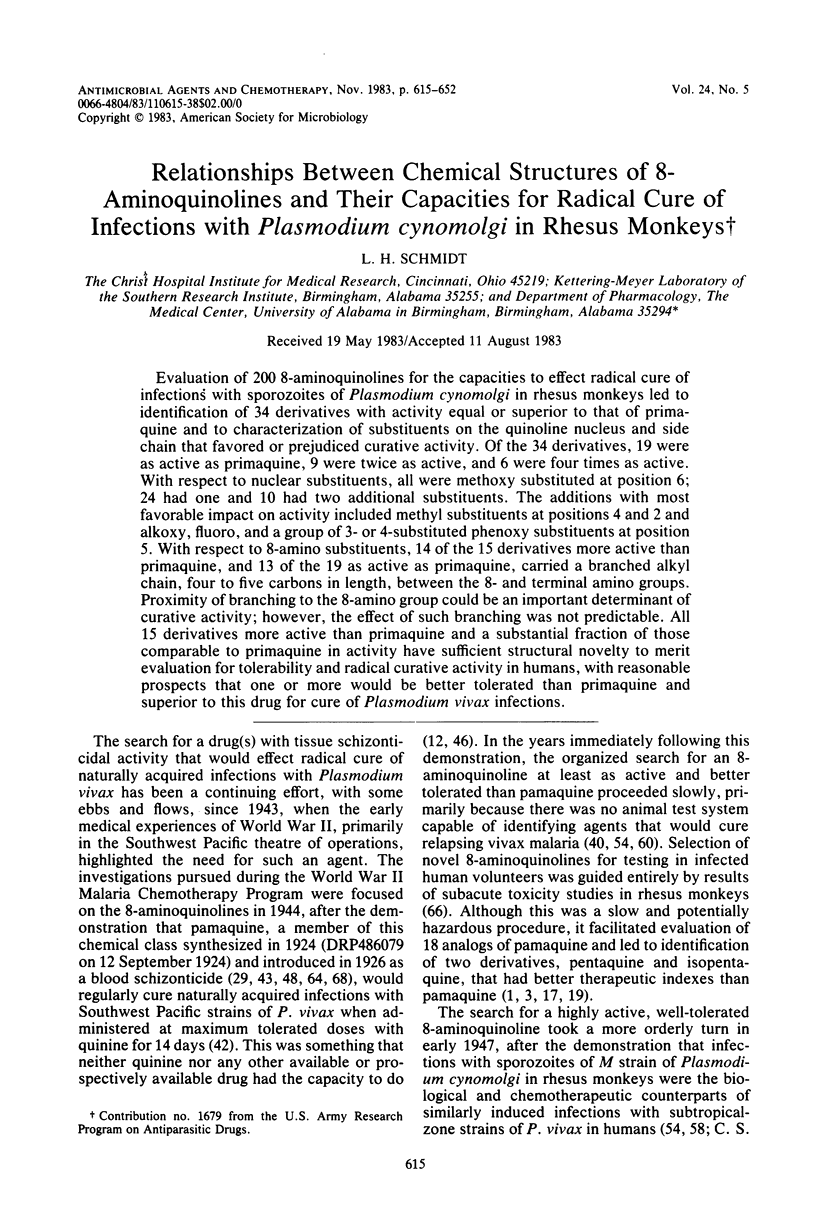
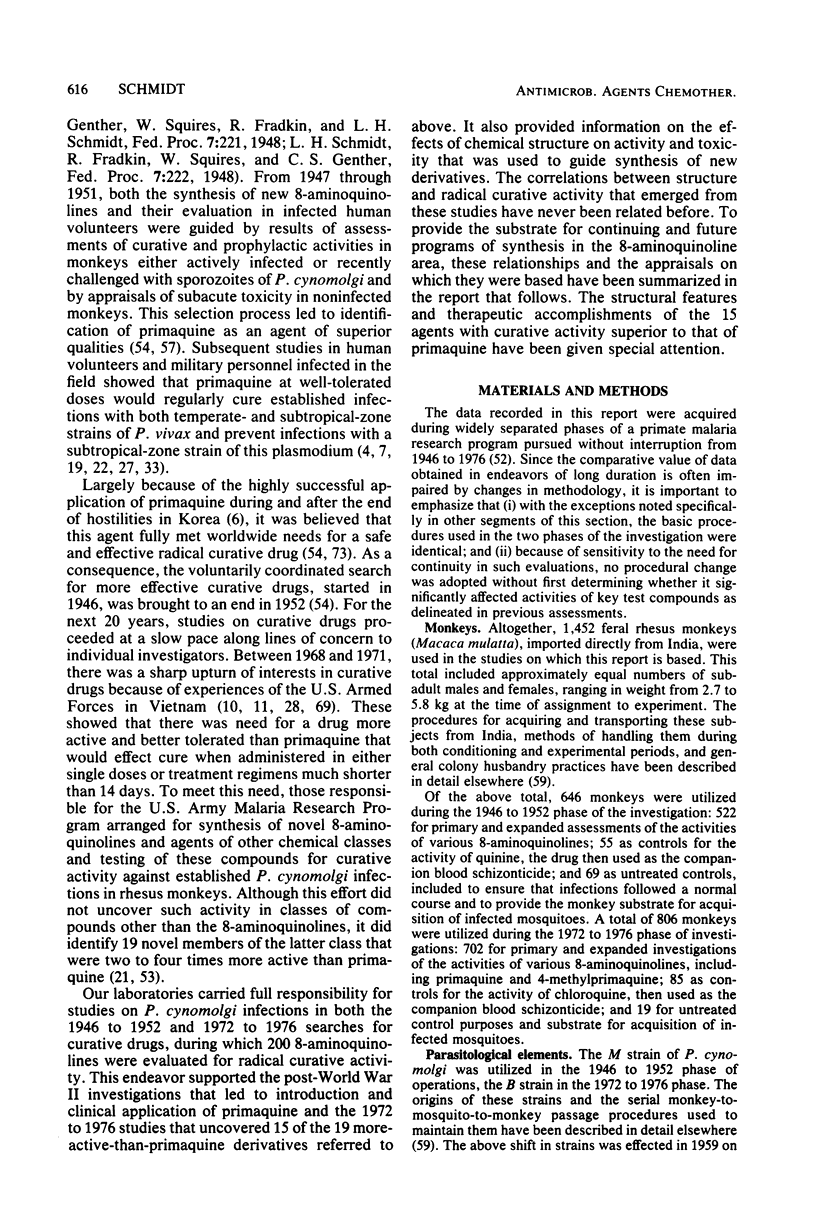
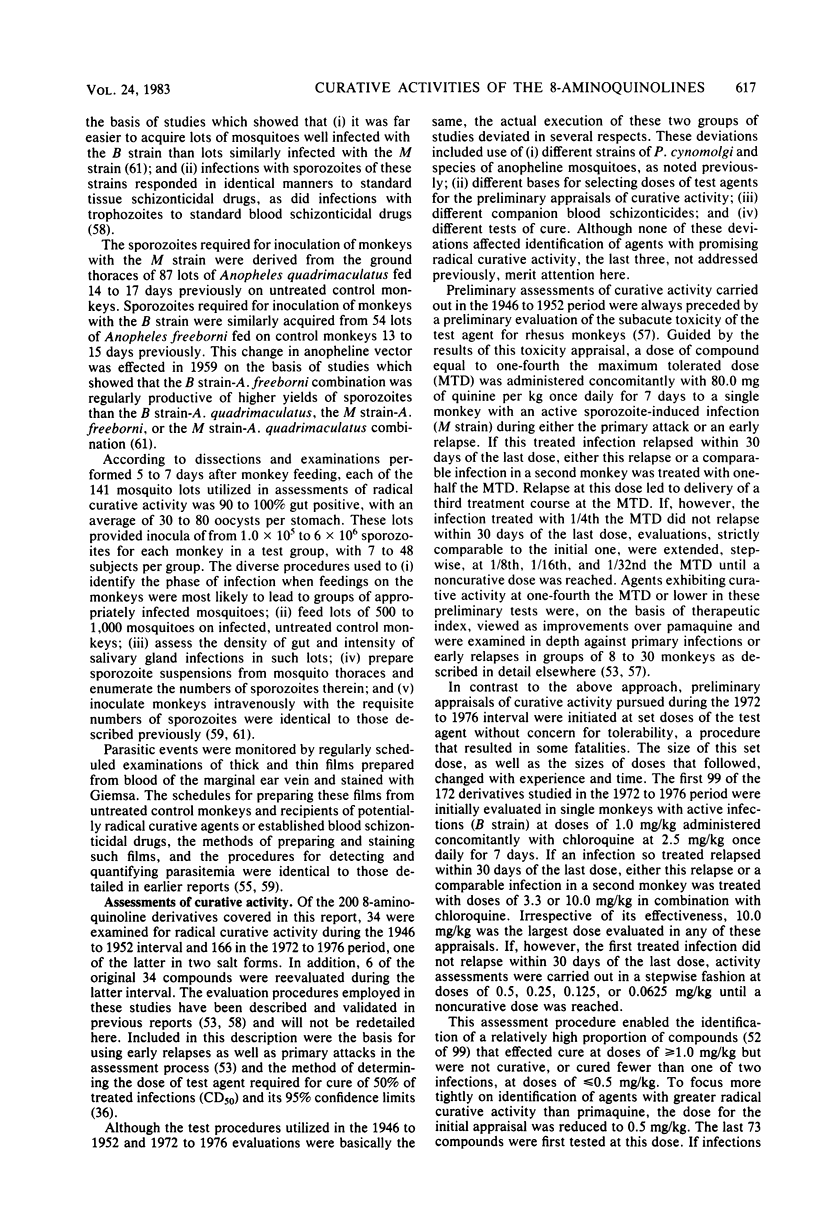
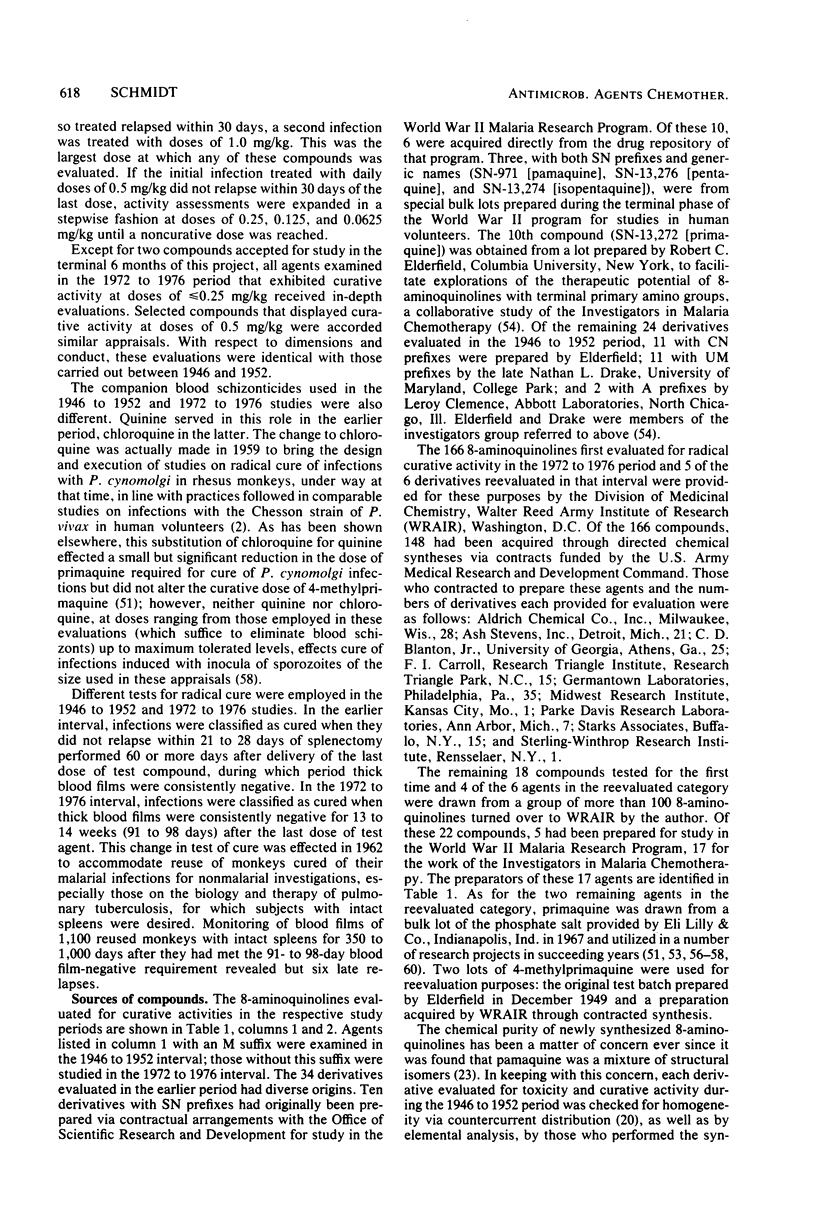
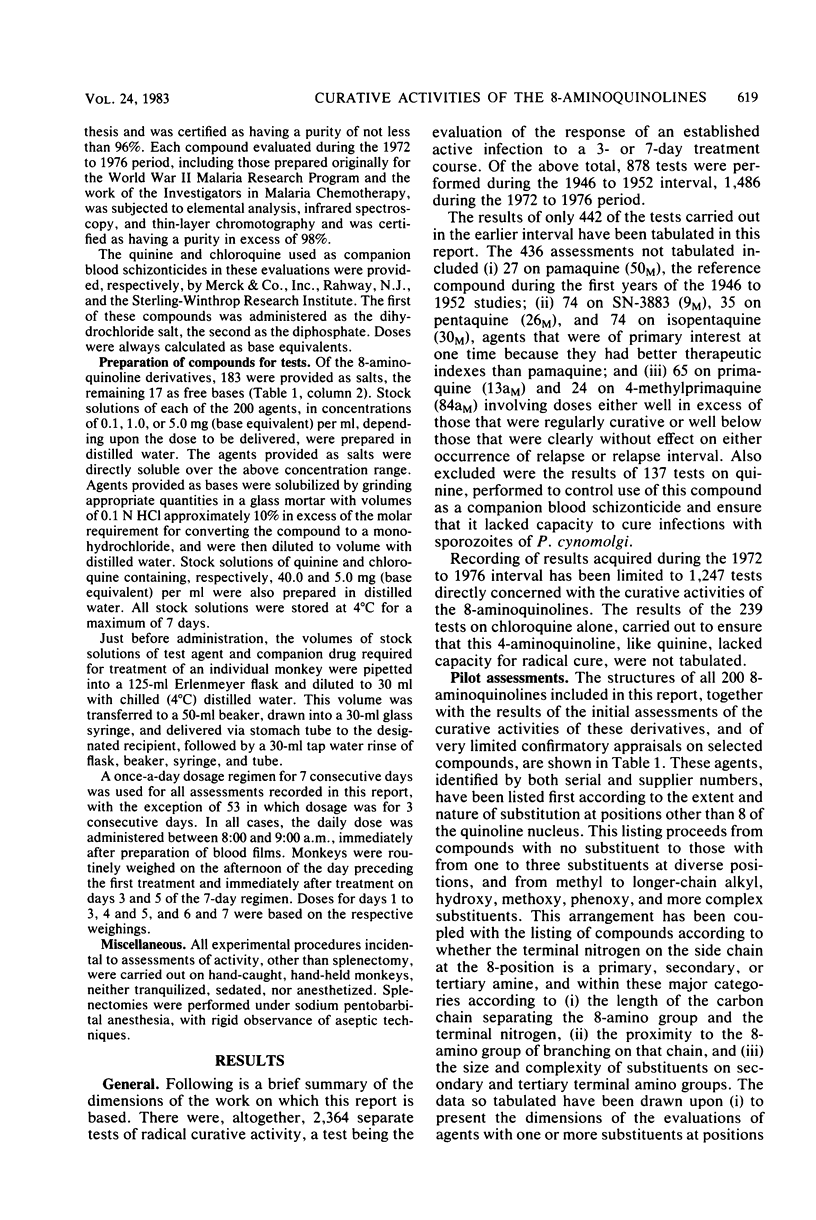

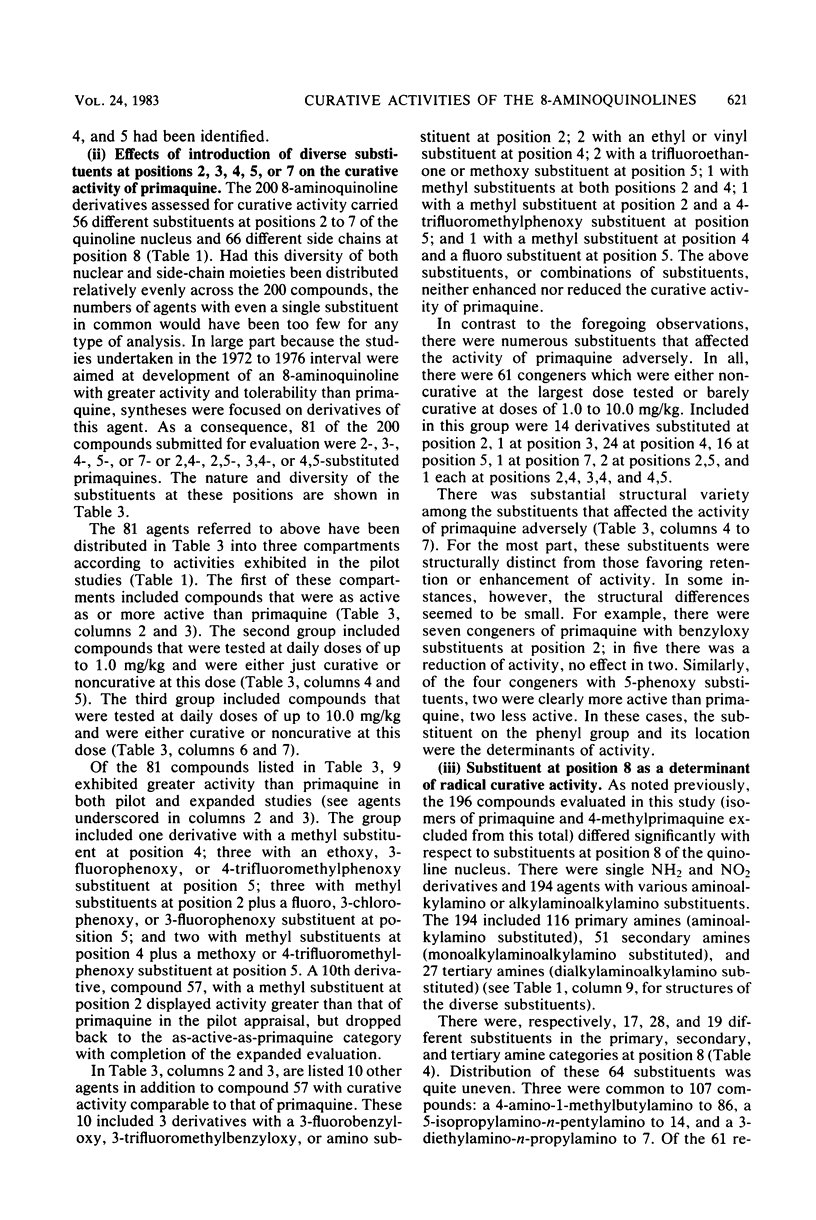
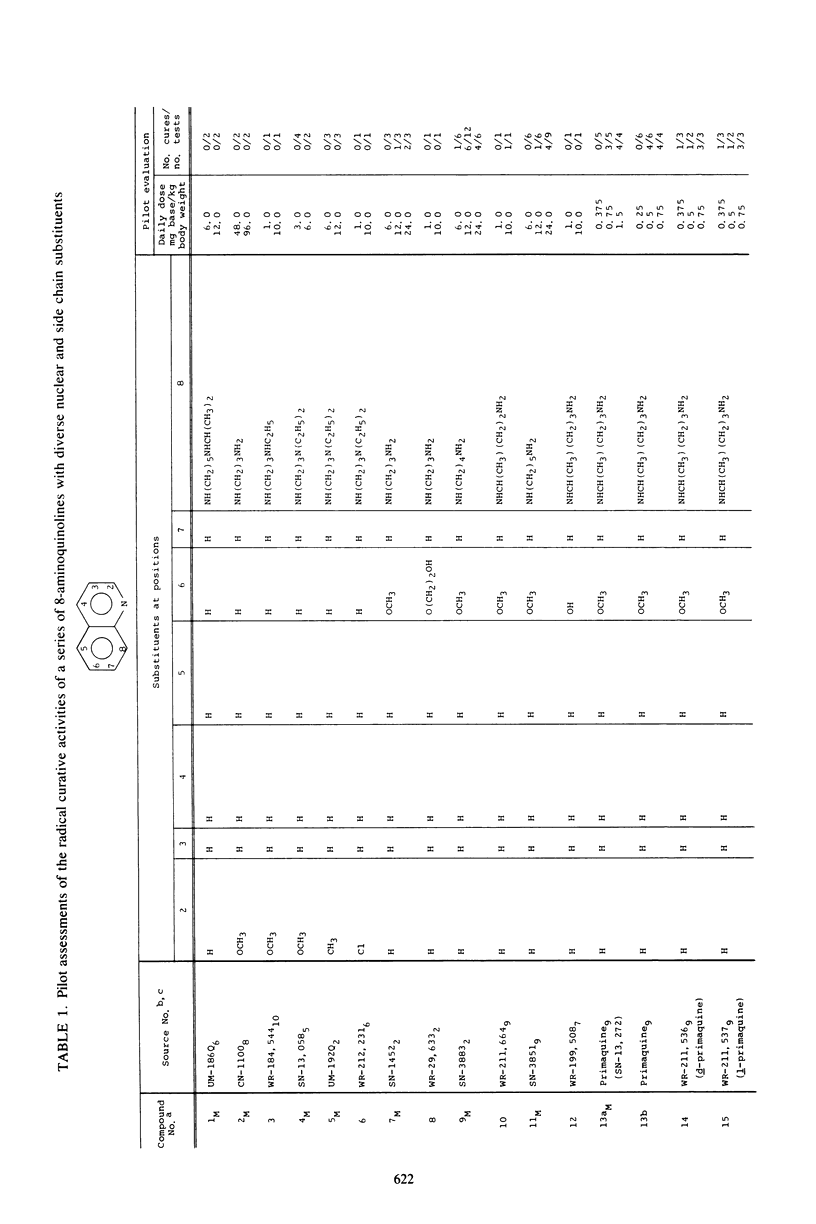
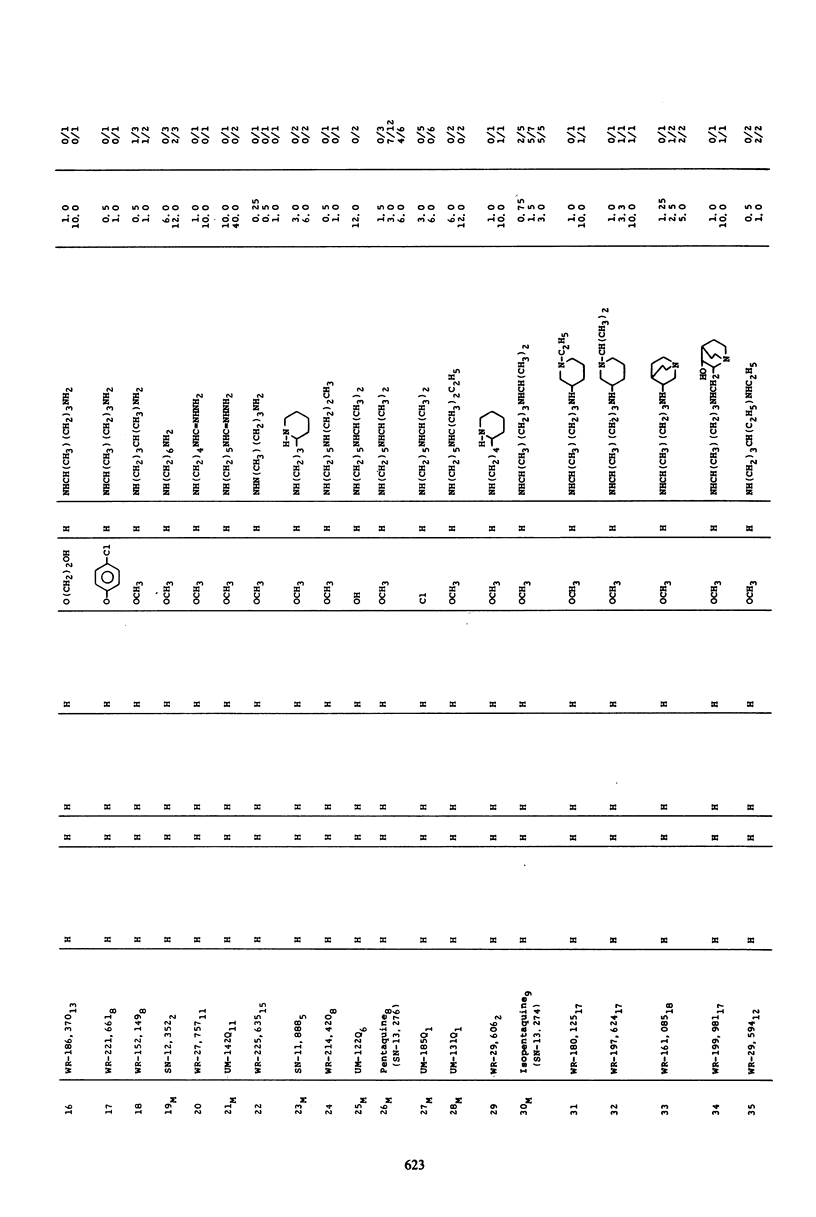
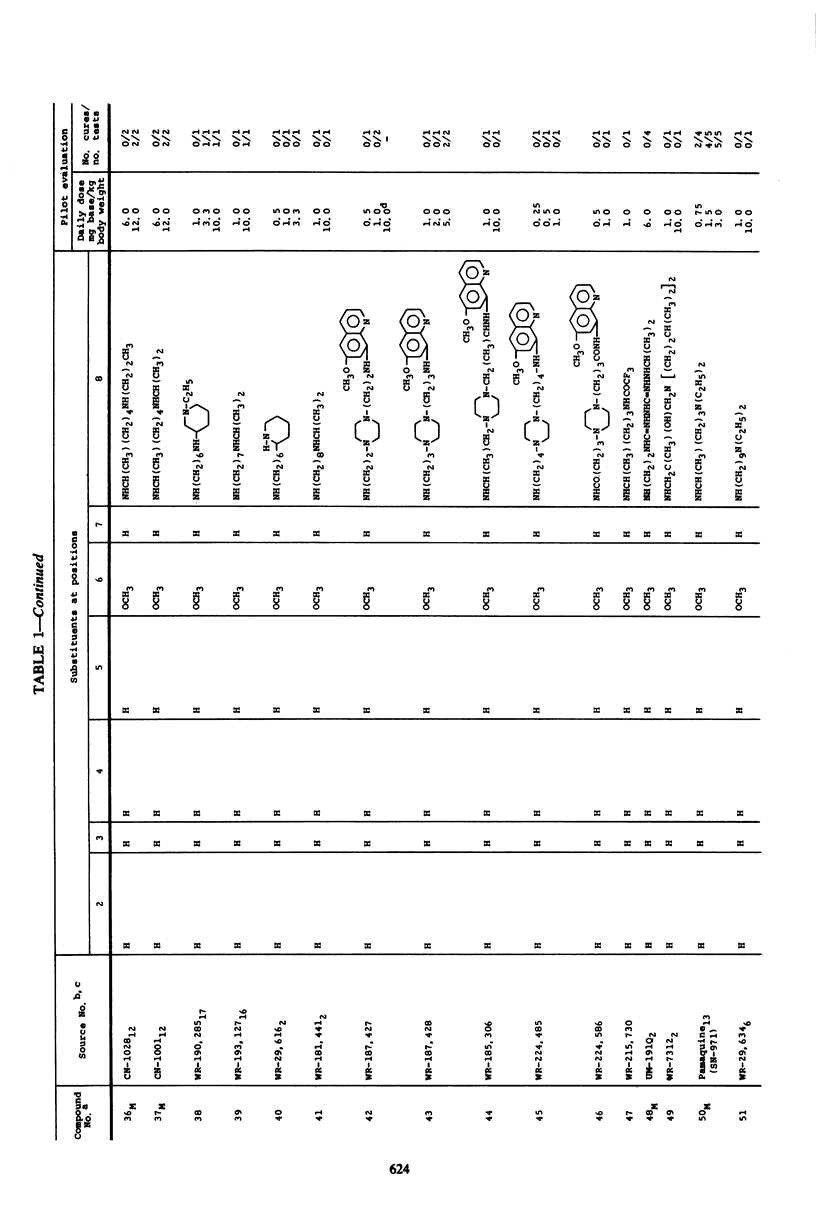

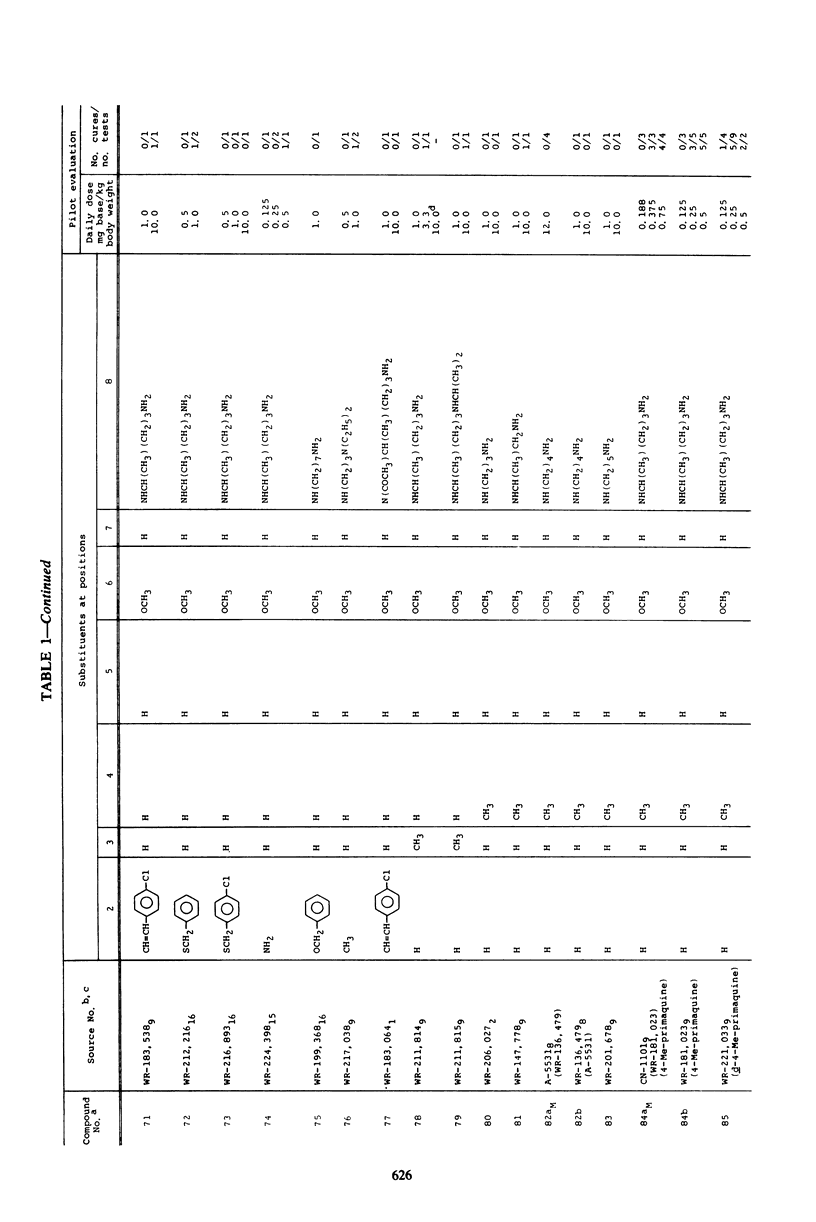
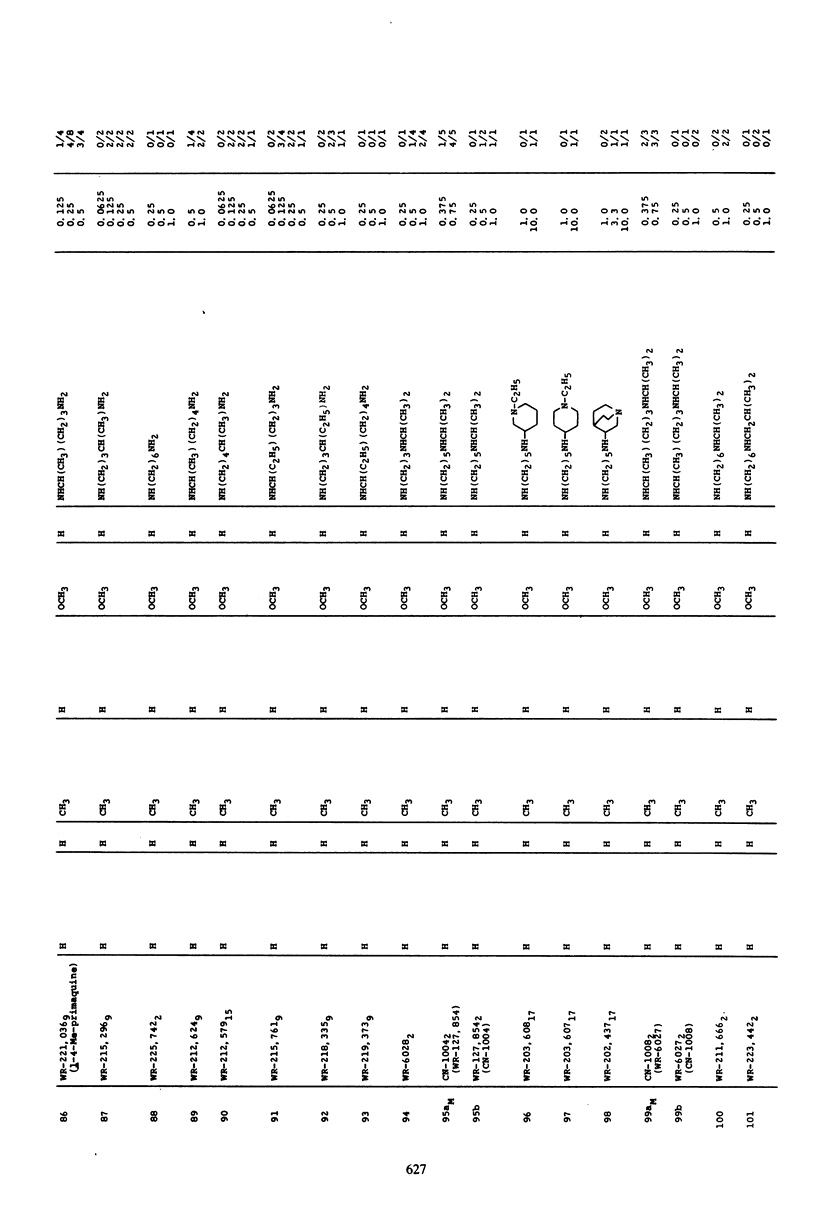
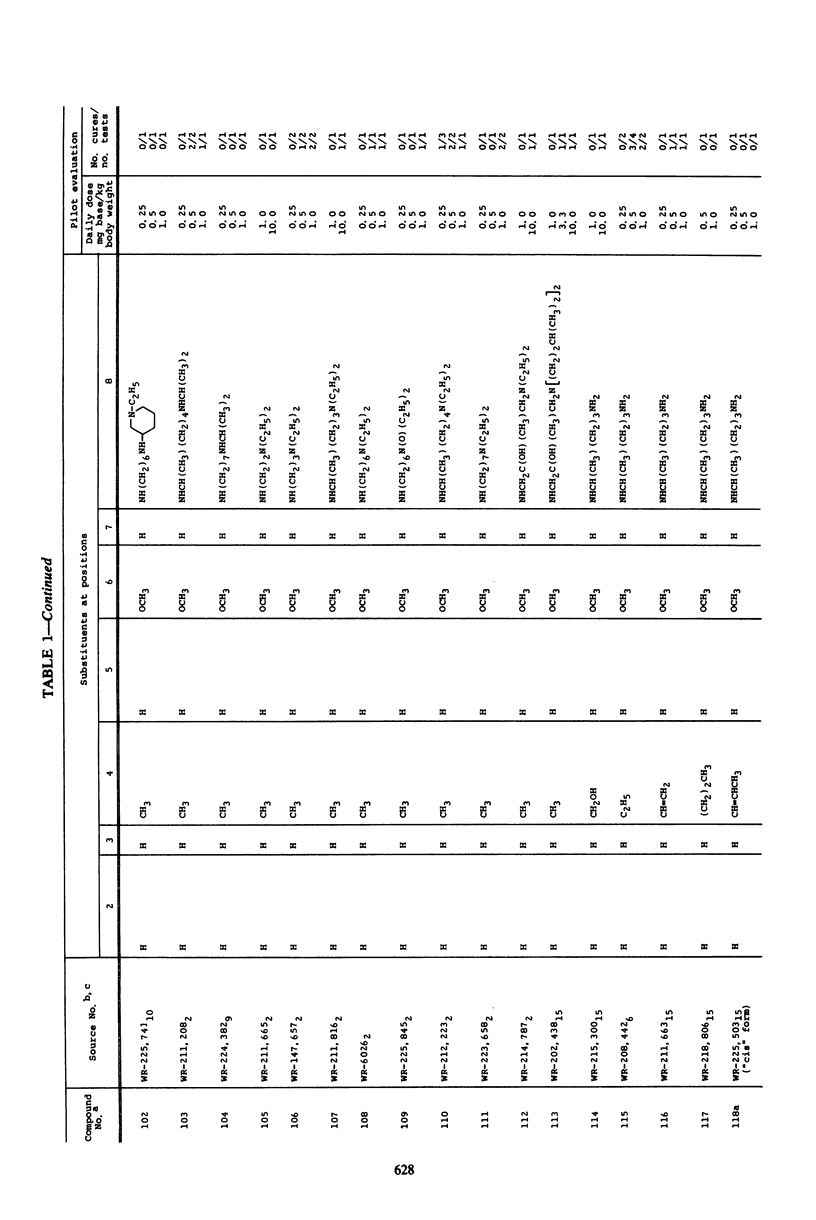

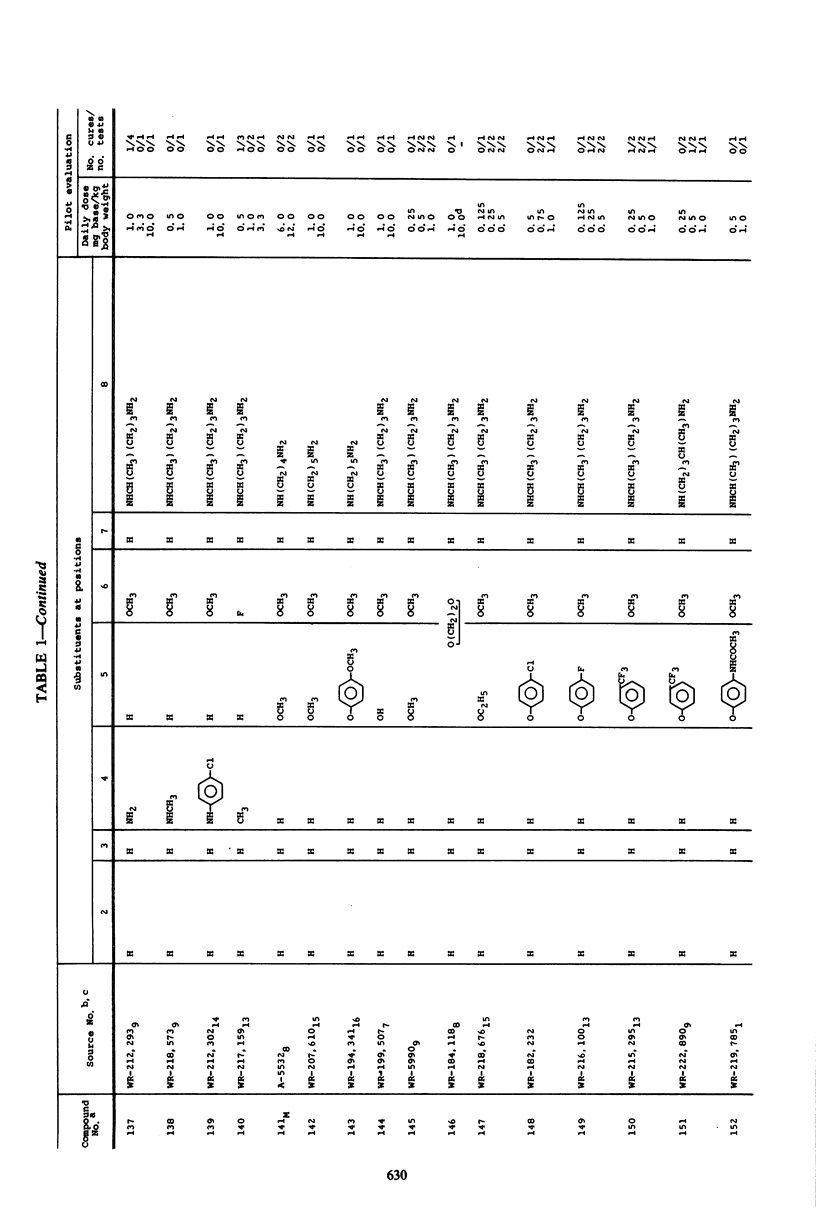
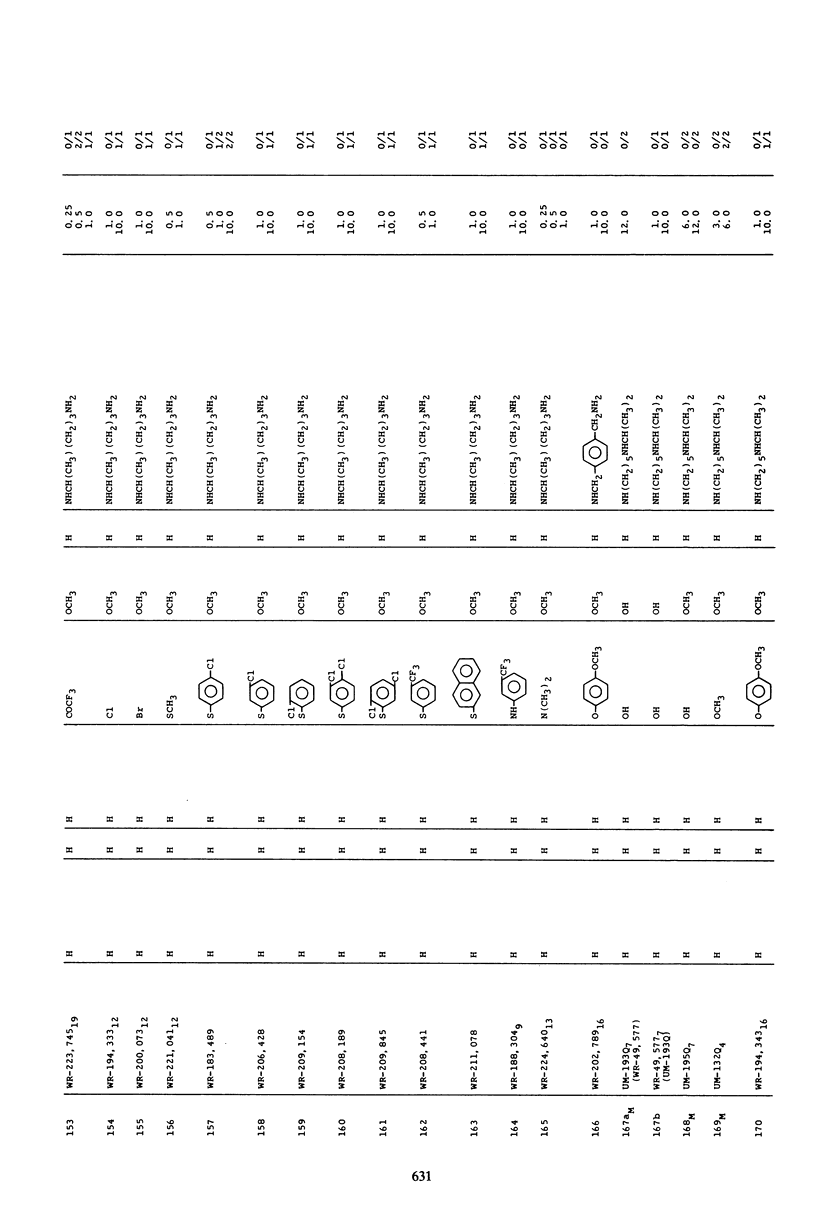
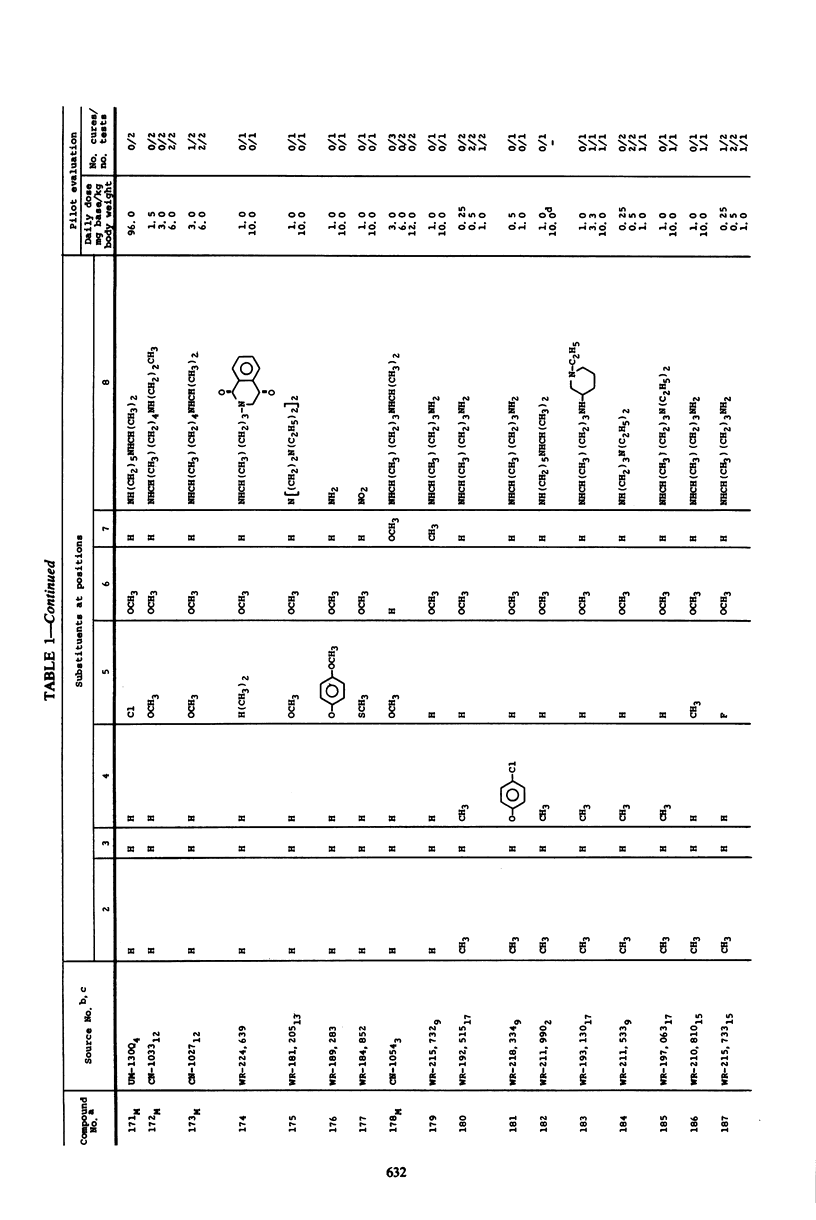

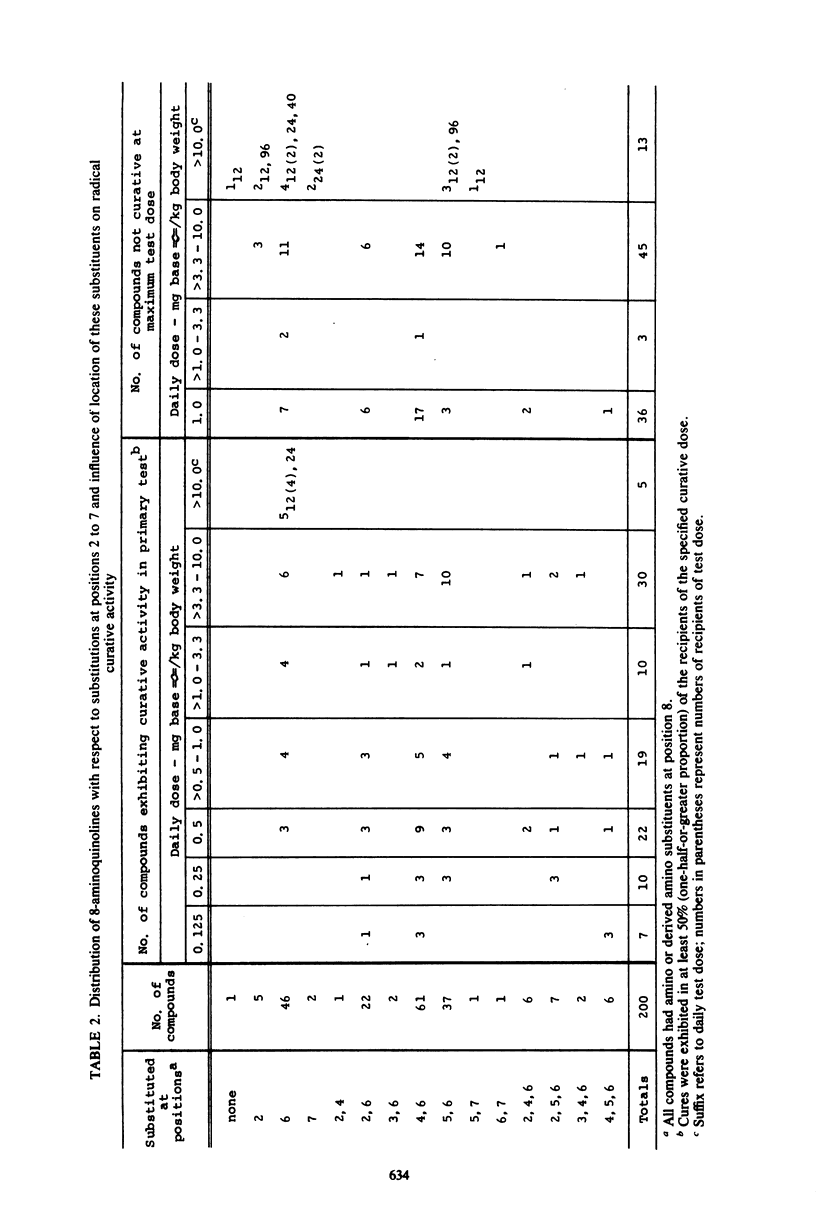
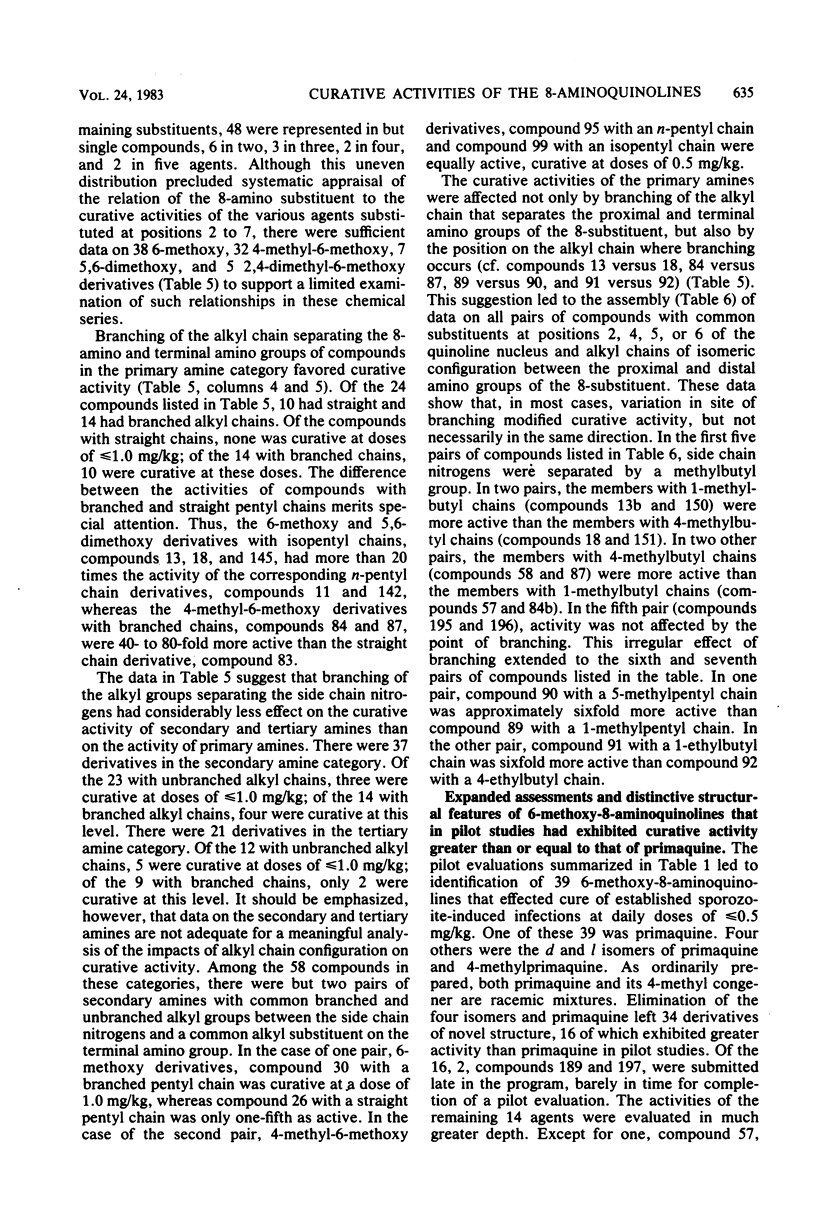
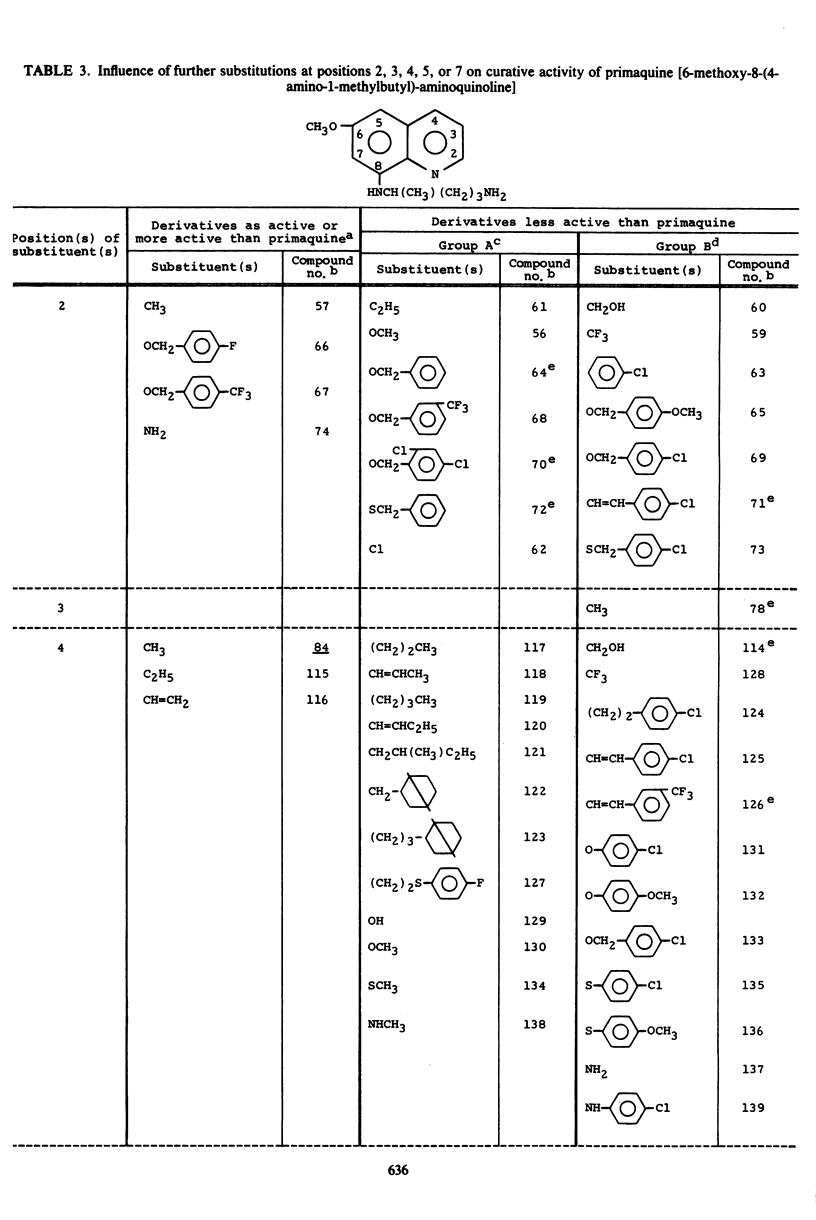
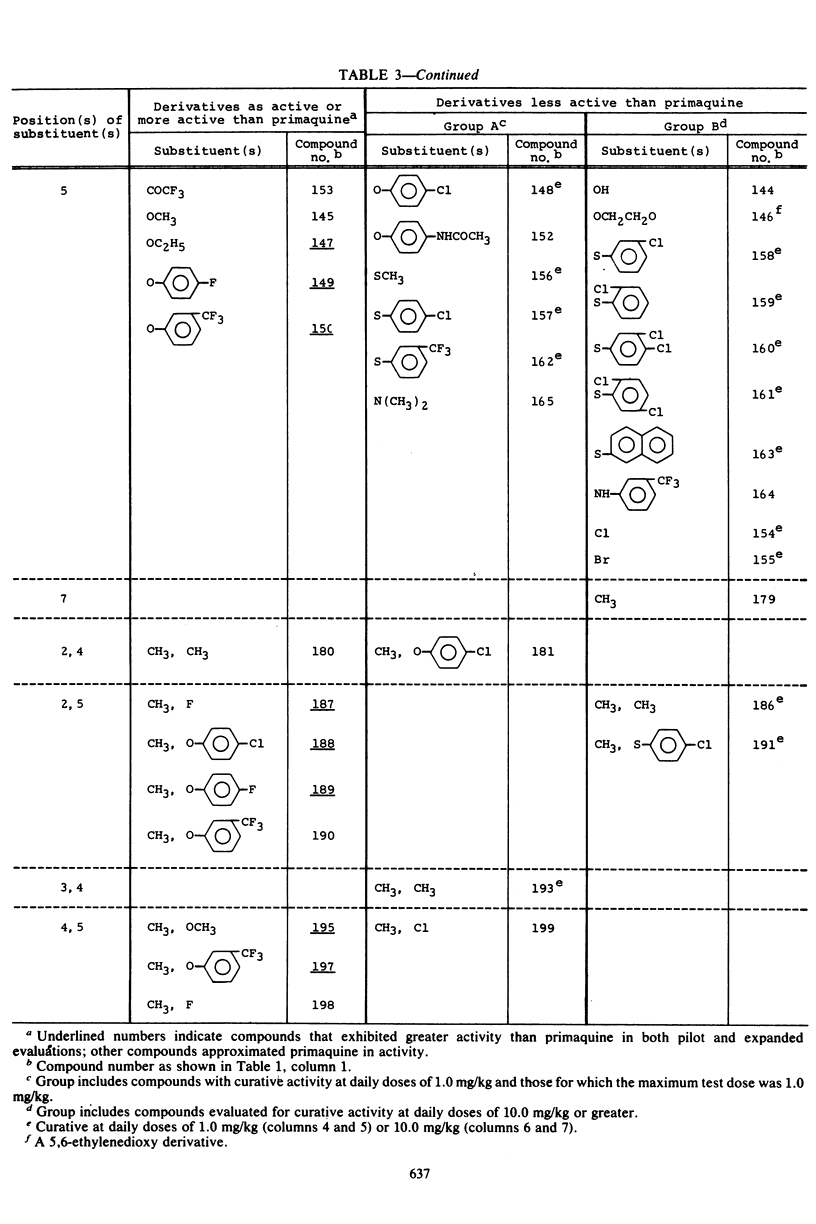
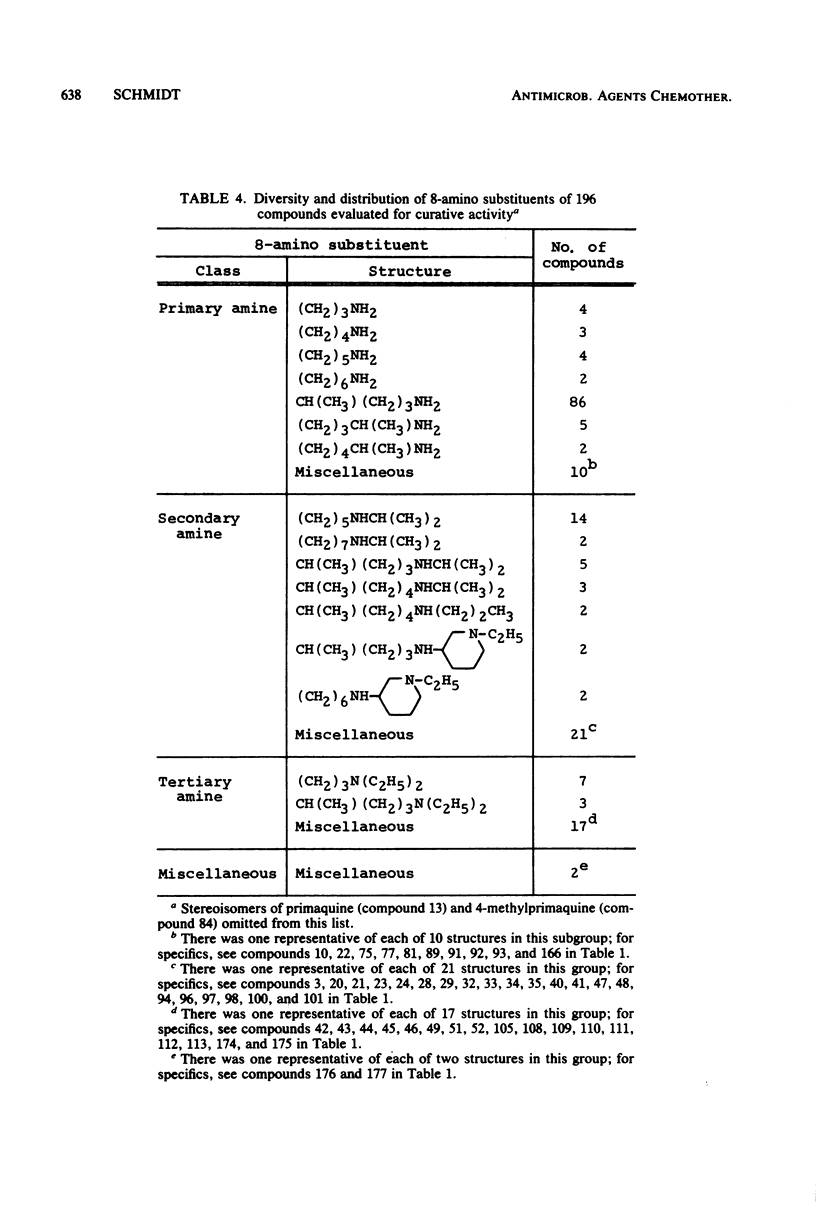
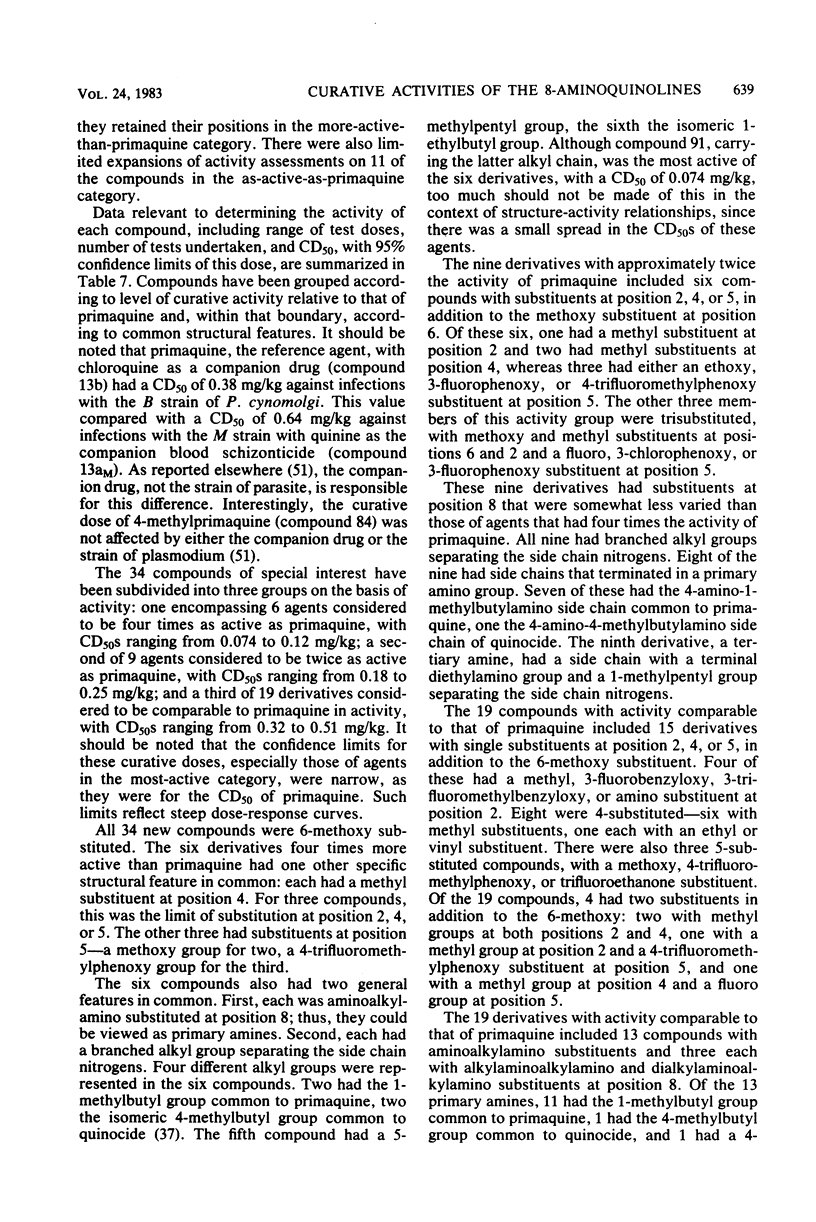
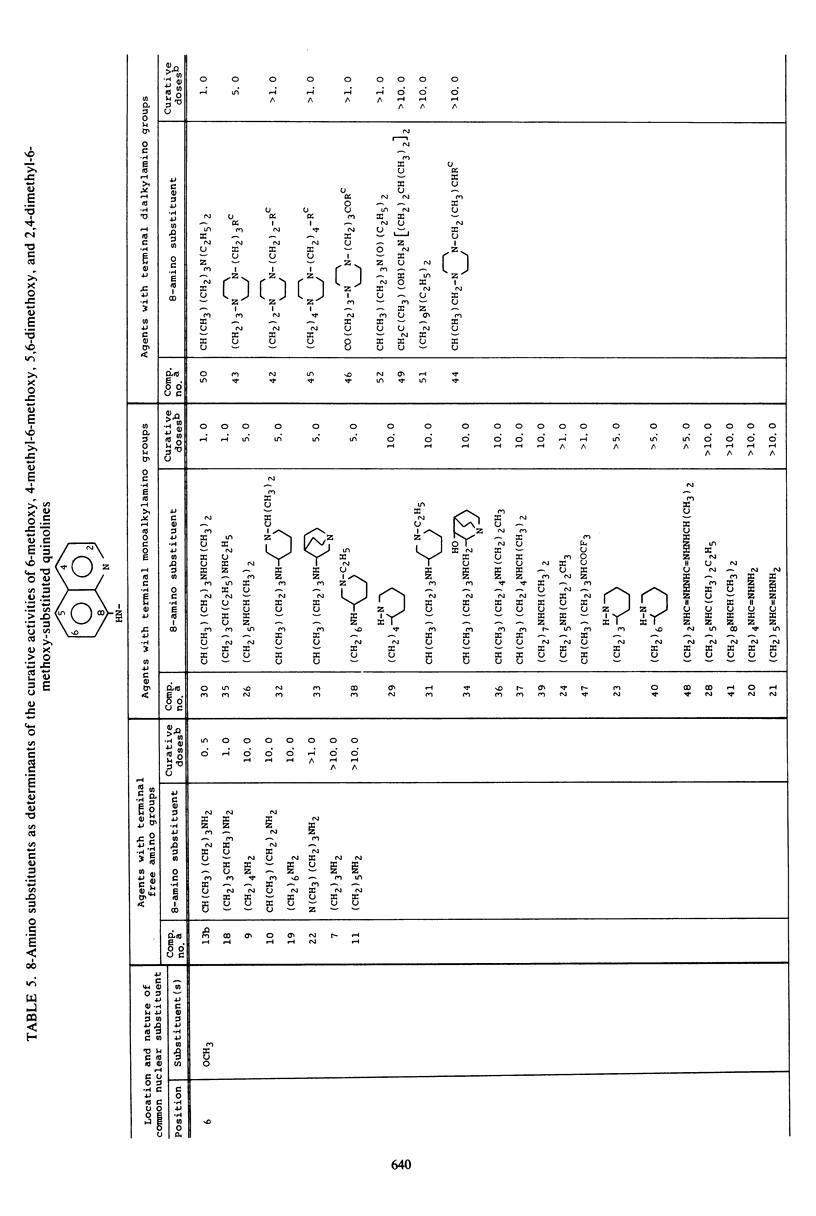
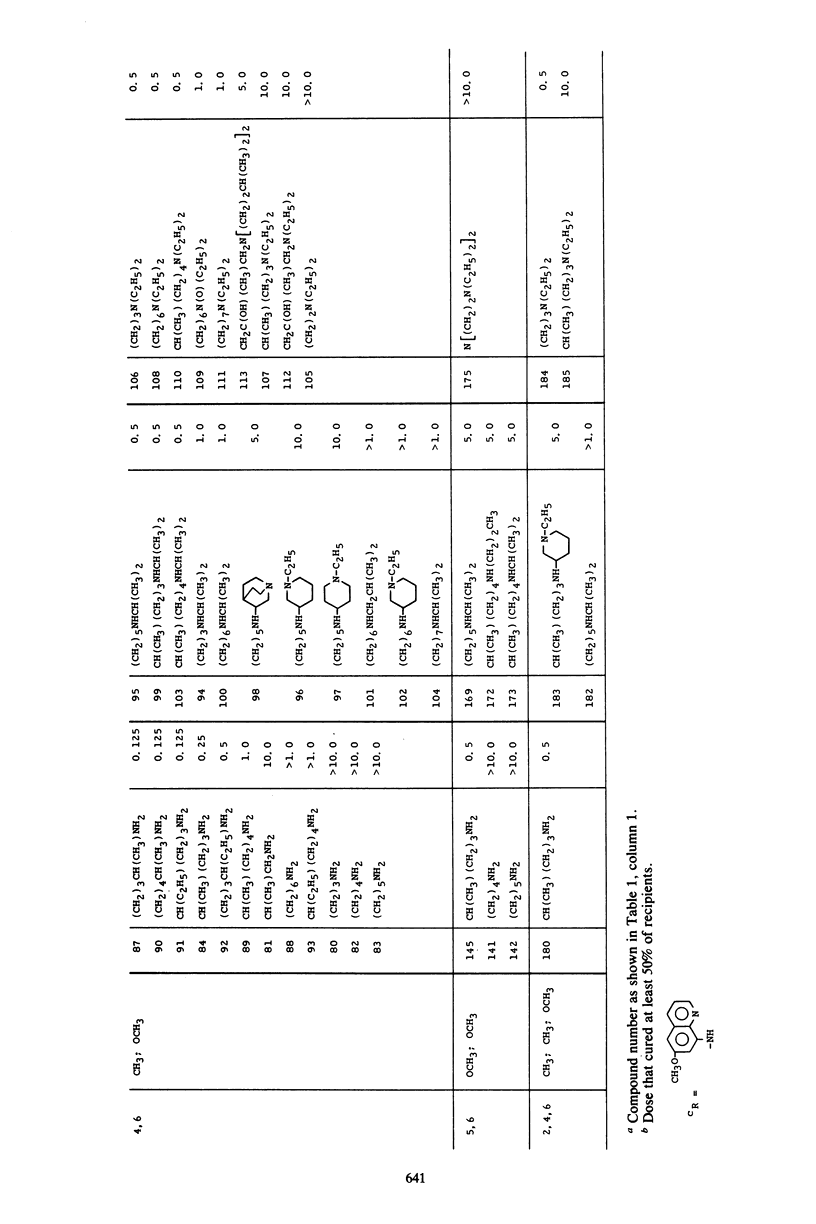

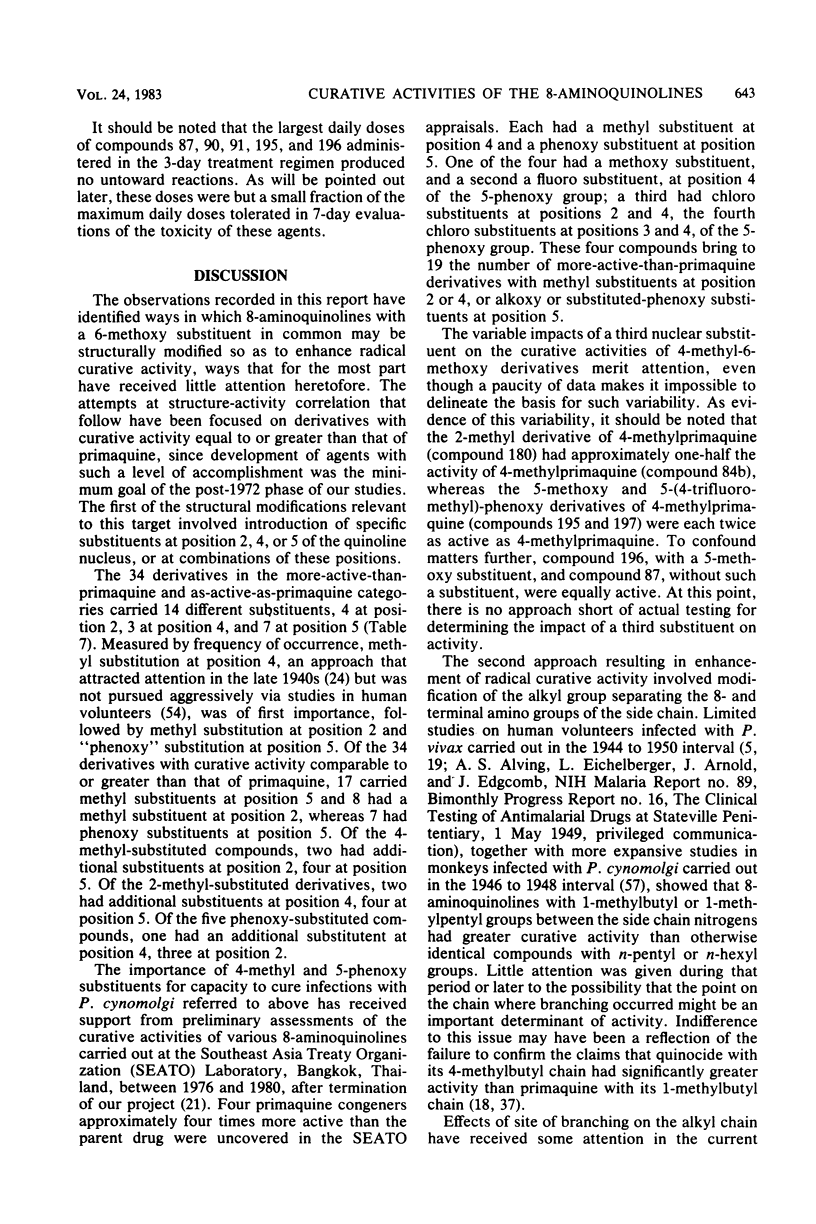
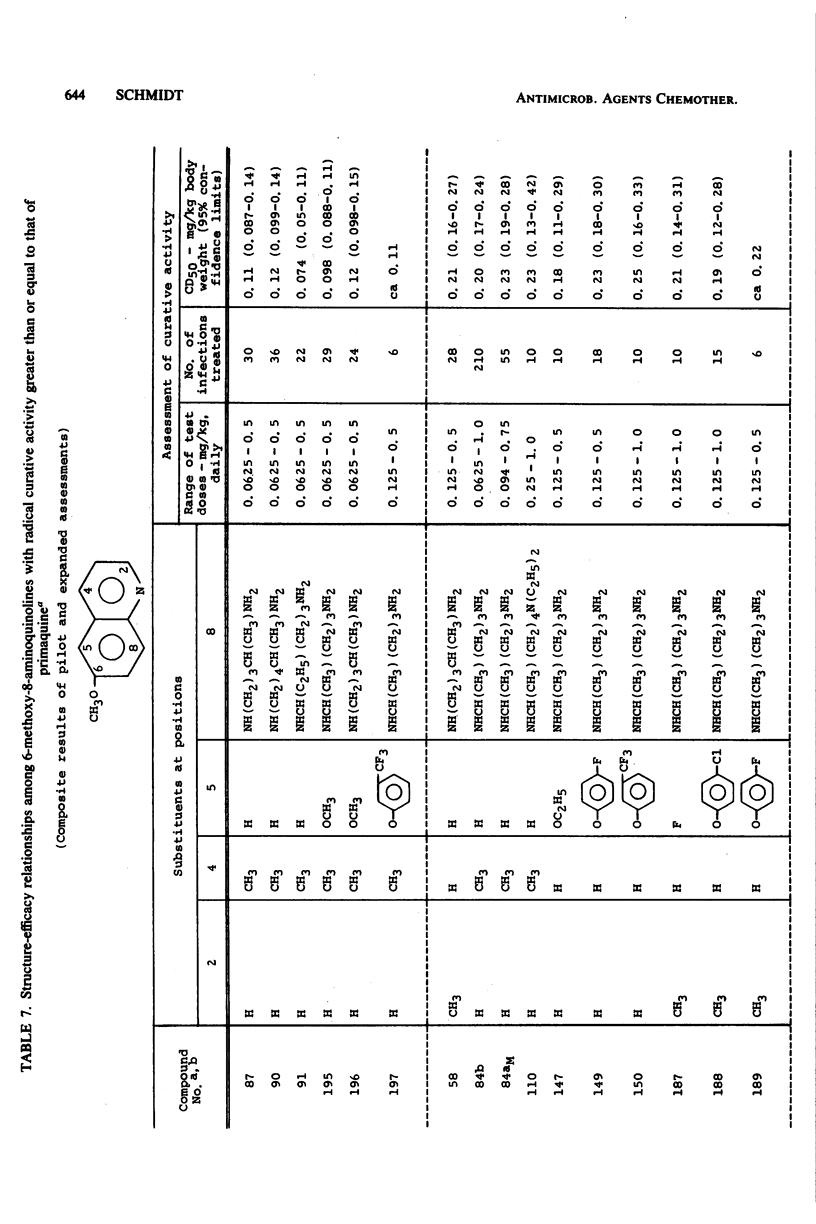
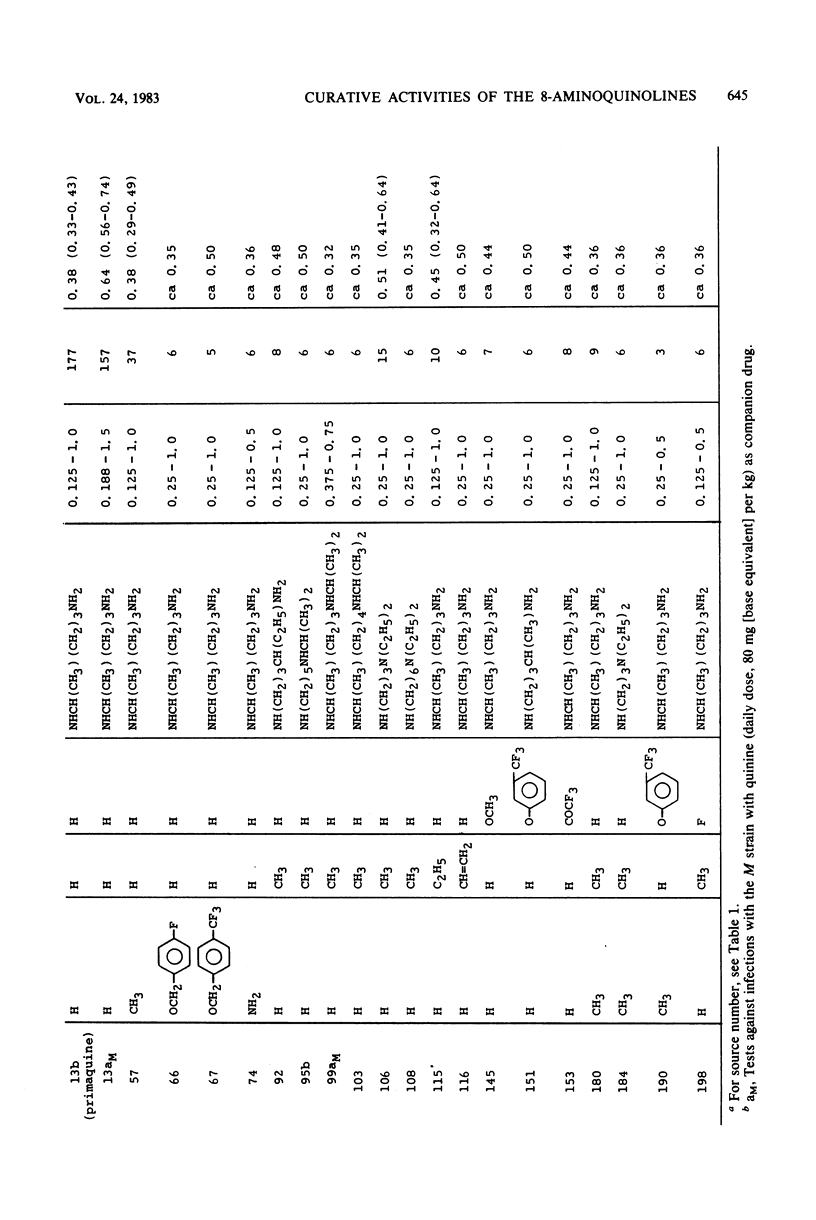
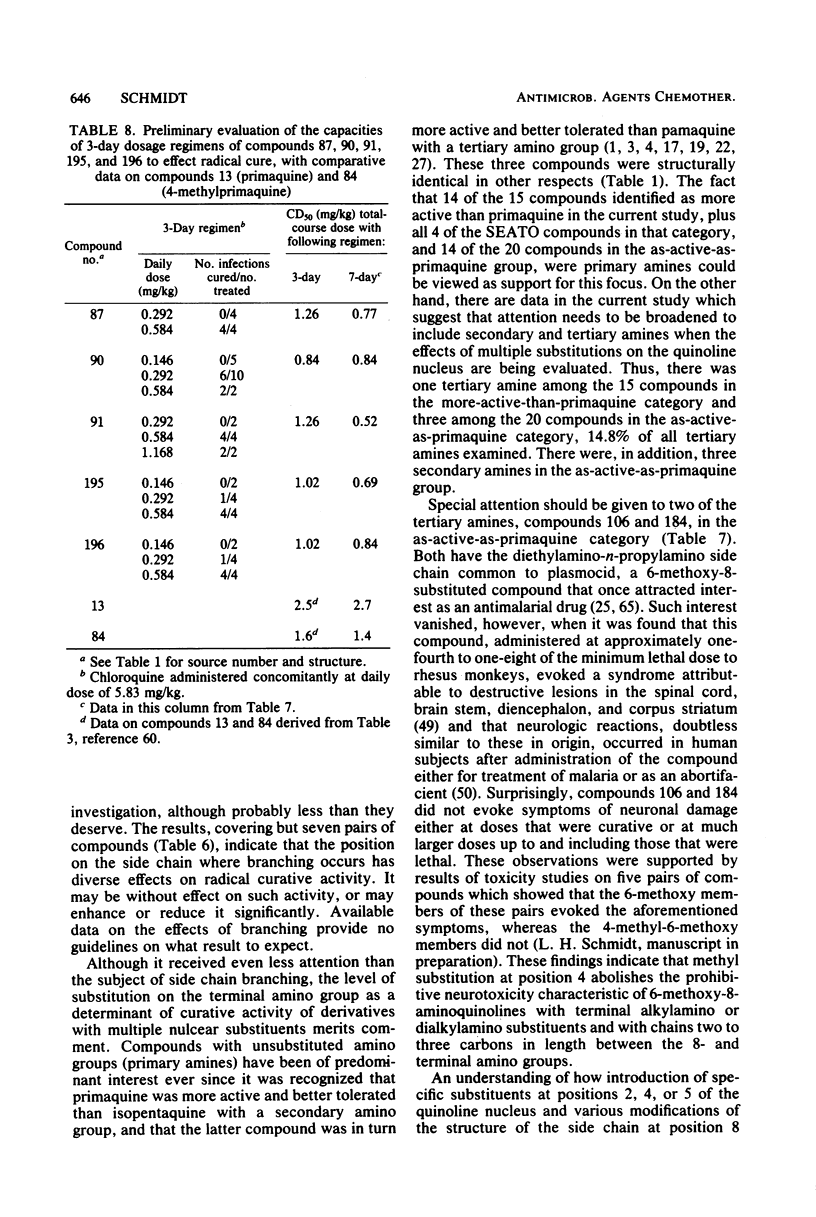
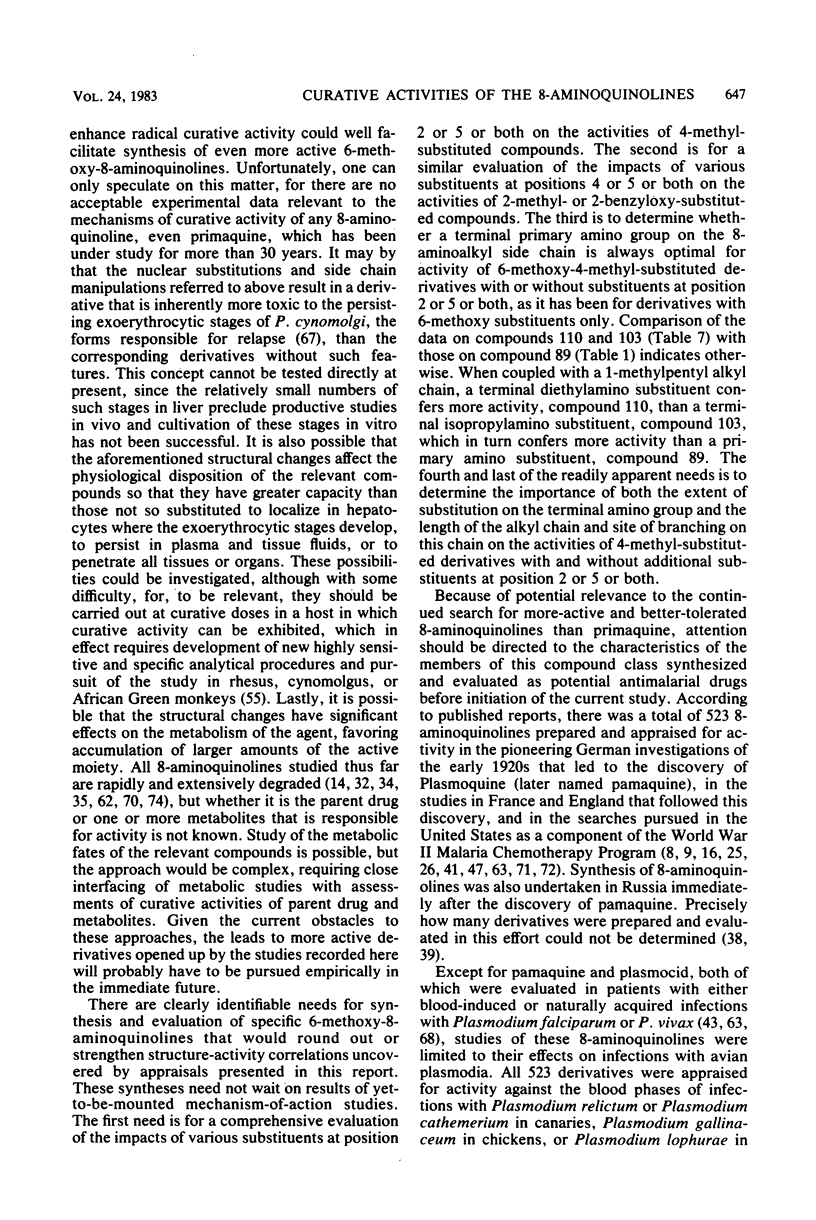
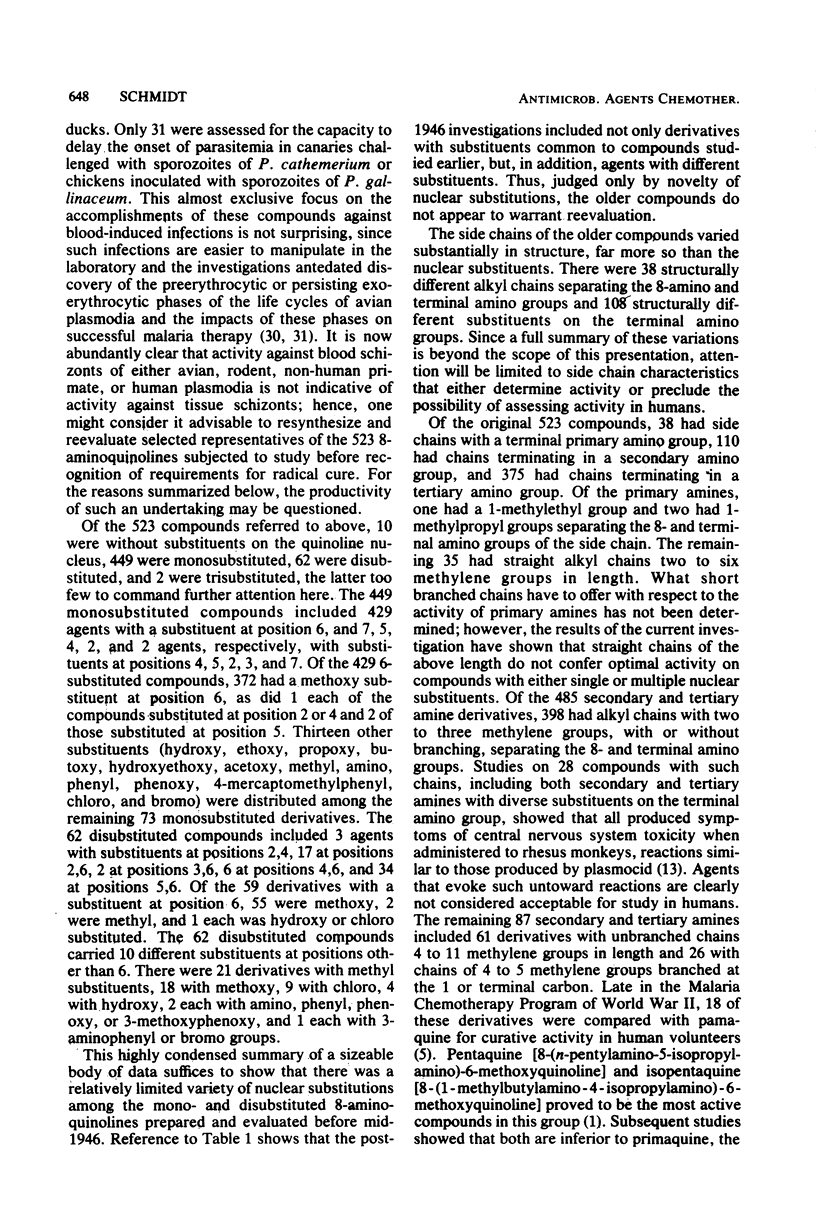
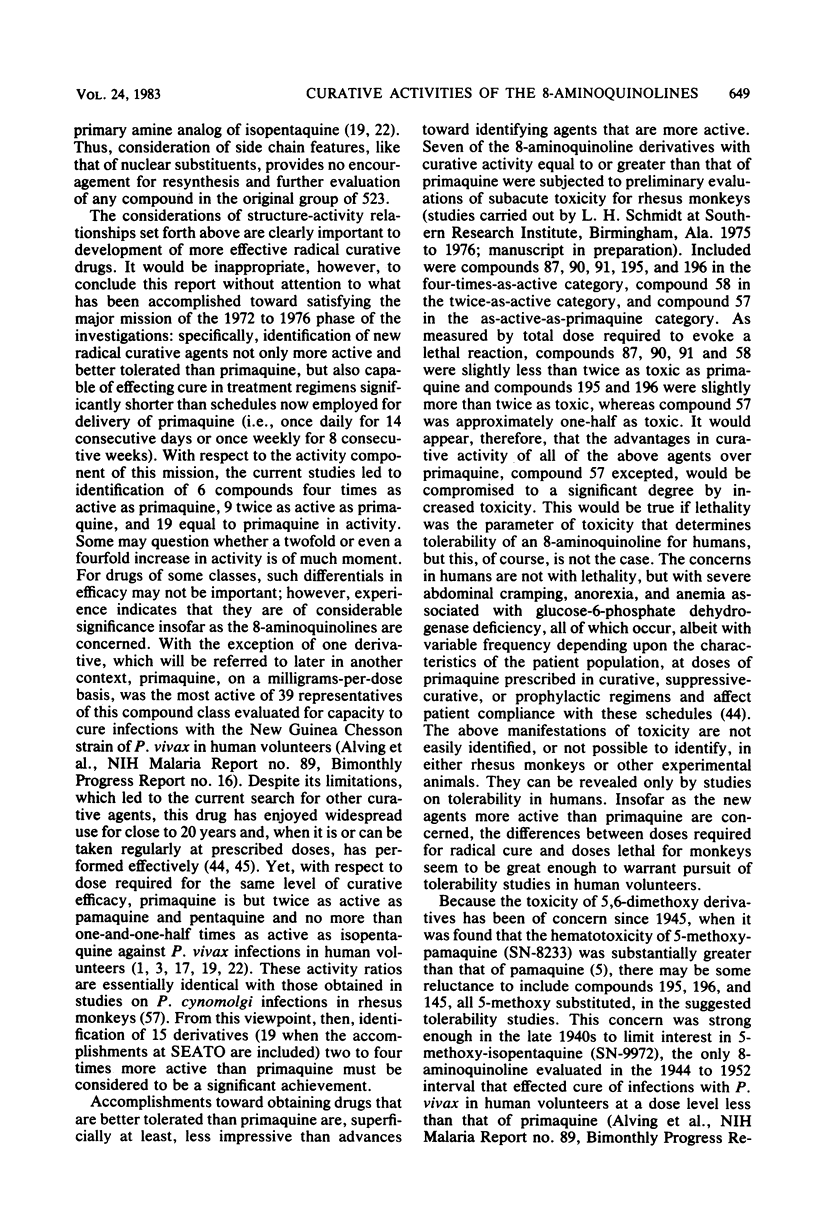
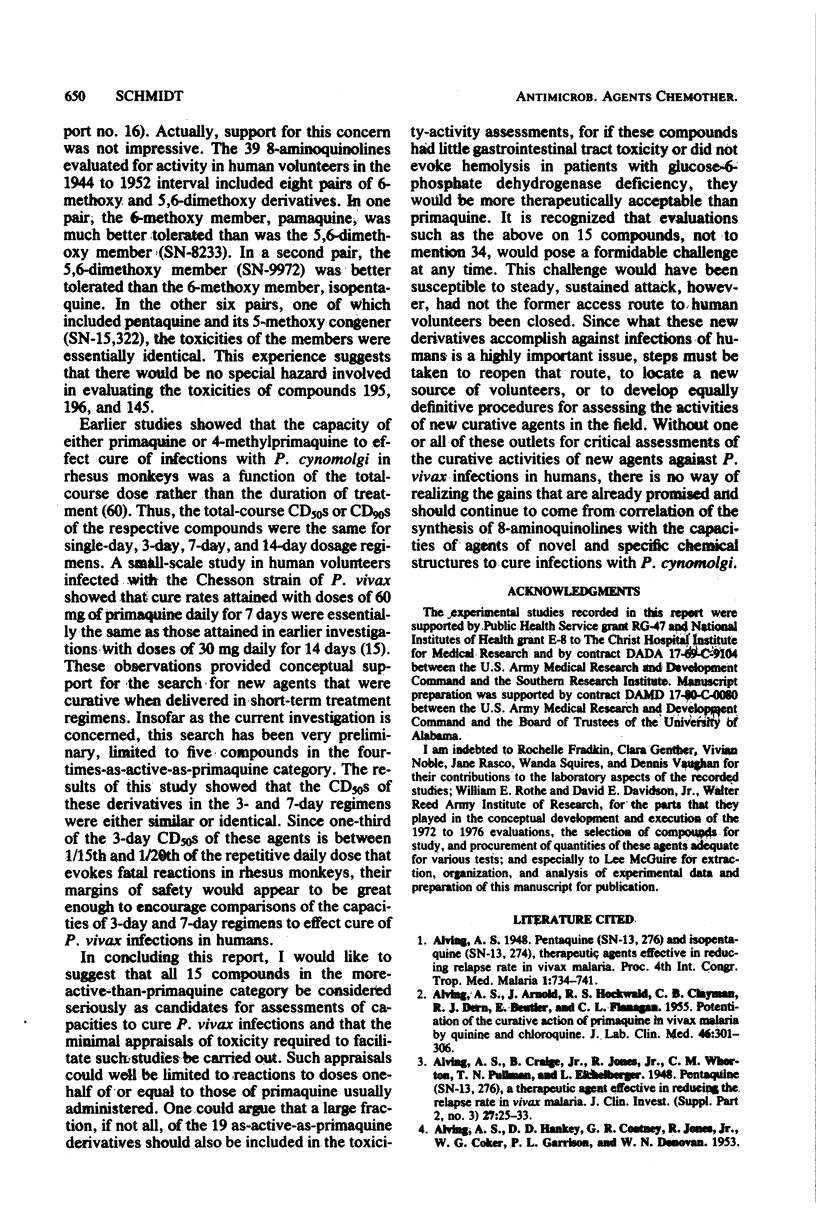
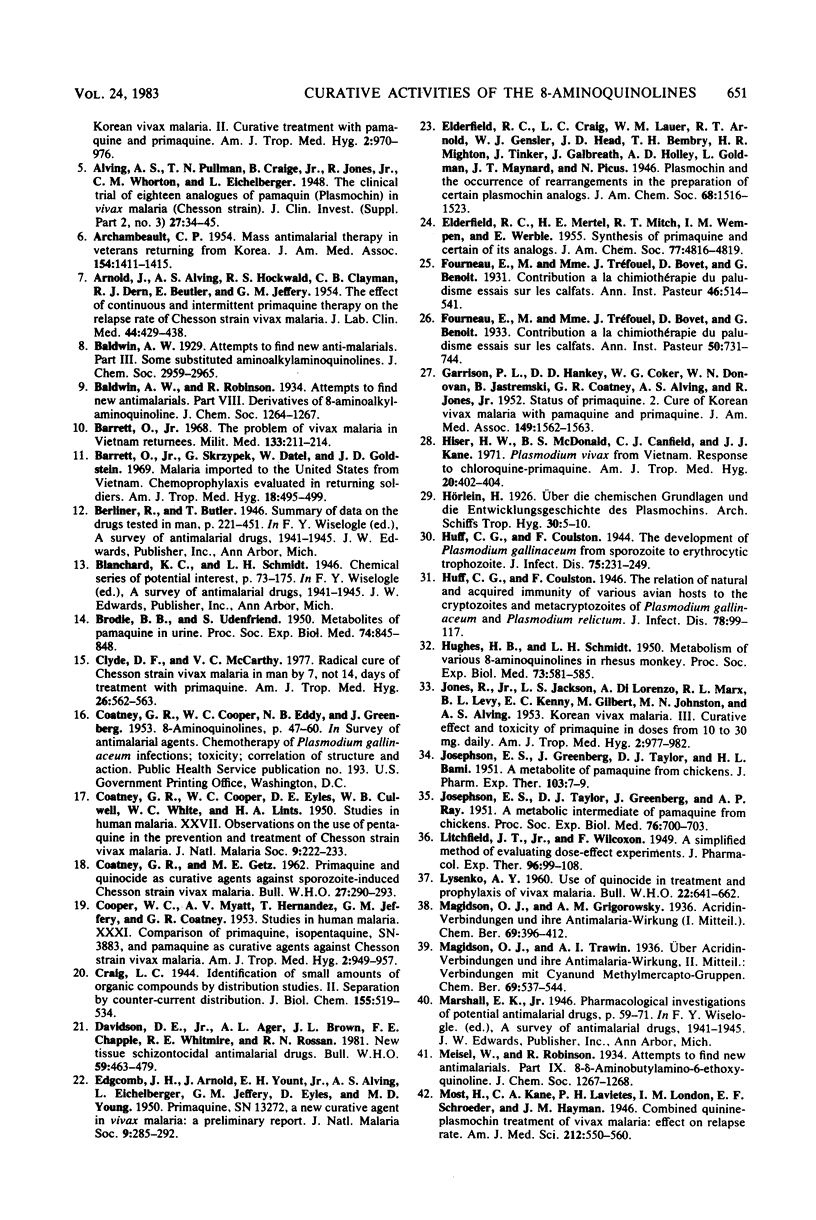
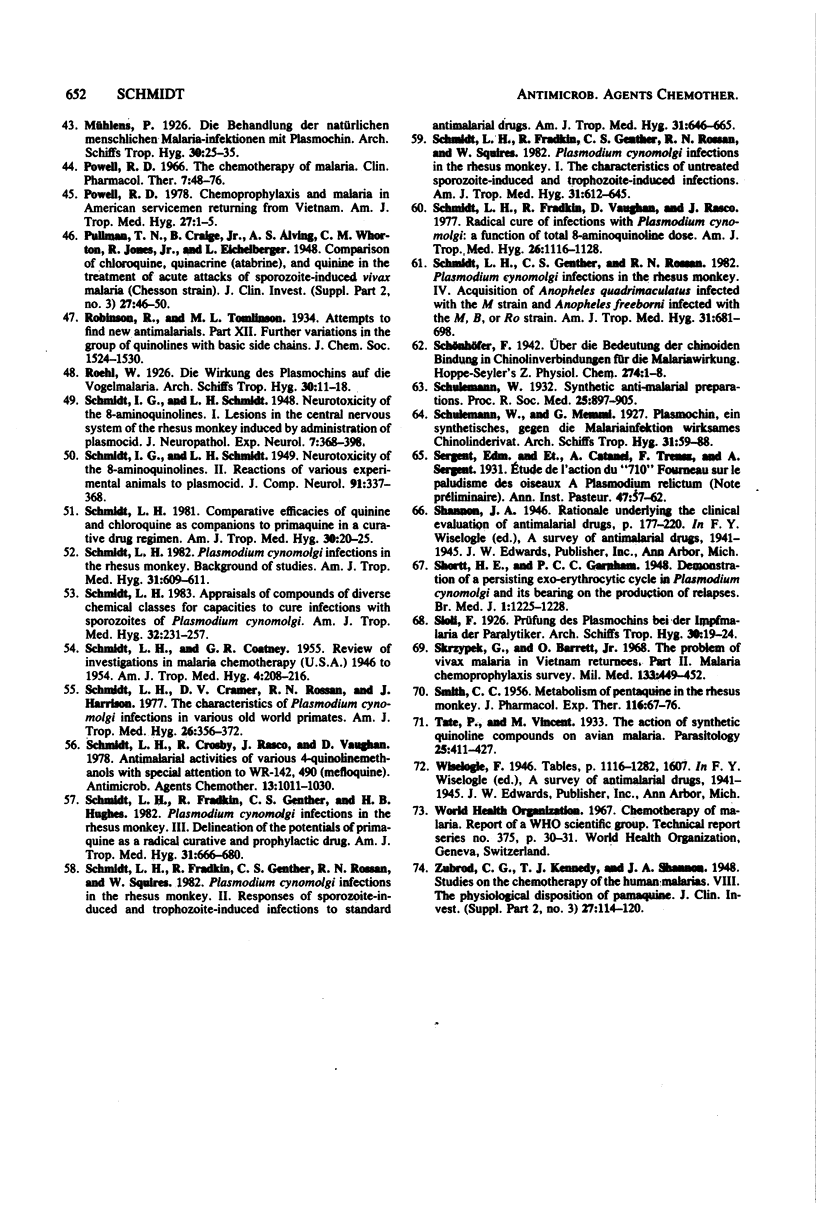
Selected References
These references are in PubMed. This may not be the complete list of references from this article.
- ARCHAMBEAULT C. P. Mass antimalarial therapy in veterans returning from Korea. J Am Med Assoc. 1954 Apr 24;154(17):1411–1415. doi: 10.1001/jama.1954.02940510011005. [DOI] [PubMed] [Google Scholar]
- ARNOLD J., ALVING A. S., HOCKWALD R. S., CLAYMAN C. B., DERN R. J., BEUTLER E., JEFFERY G. M. The effect of continuous and intermittent primaquine therapy on the relapse rate of Chesson strain vivax malaria. J Lab Clin Med. 1954 Sep;44(3):429–438. [PubMed] [Google Scholar]
- Alving A. S., Pullman T. N., Craige B., Jones R., Whorton C. M., Eichelberger L. THE CLINICAL TRIAL OF EIGHTEEN ANALOGUES OF PAMAQUIN (PLASMOCHIN) IN VIV AX MALARIA (CHESSON STRAIN). J Clin Invest. 1948 May;27(3 Pt 2):34–45. doi: 10.1172/JCI101963. [DOI] [PMC free article] [PubMed] [Google Scholar]
- BRODIE B. B., UDENFRIEND S. Metabolites of pamaquine in urine. Proc Soc Exp Biol Med. 1950 Aug;74(4):845–848. doi: 10.3181/00379727-74-18065. [DOI] [PubMed] [Google Scholar]
- BUGHES H. B., SCHMIDT L. H. Metabolism of various 8-aminoquinolines in rhesus monkey. Proc Soc Exp Biol Med. 1950 Apr;73(4):581–585. doi: 10.3181/00379727-73-17751. [DOI] [PubMed] [Google Scholar]
- Barrett O., Jr, Skrzypek G., Datel W., Goldstein J. D. Malaria imported to the United States from Vietnam. Chemoprophylaxis evaluated in returning soldiers. Am J Trop Med Hyg. 1969 Jul;18(4):495–499. doi: 10.4269/ajtmh.1969.18.495. [DOI] [PubMed] [Google Scholar]
- Barrett O., Jr The problem of vivax malaria in Vietnam returnees. Mil Med. 1968 Mar;133(3):211–214. [PubMed] [Google Scholar]
- COATNEY G. R., COOPER W. C., EYLES D. E., CULWELL W. B., WHITE W. C., LINTS H. A. Studies in human malaria. XXVII. Observations on the use of pentaquine in the prevention and treatment of Chesson strain vivax malaria. J Natl Malar Soc. 1950 Sep;9(3):222–233. [PubMed] [Google Scholar]
- COATNEY G. R., GETZ M. E. Primaquine and quinocide as curative agents against sporozoite-induced Chesson strain vivax malaria. Bull World Health Organ. 1962;27:290–293. [PMC free article] [PubMed] [Google Scholar]
- COOPER W. C., MYATT A. V., HERNANDEZ T., JEFFERY G. M., COATNEY G. R. Studies in human malaria. XXXI. Comparison of primaquine, isopentaquine, SN-3883, and pamaquine as curative agents against Chesson strain vivax malaria. Am J Trop Med Hyg. 1953 Nov;2(6):949–957. [PubMed] [Google Scholar]
- Clyde D. F., McCarthy V. C. Radical cure of Chesson strain vivax malaria in man by 7, not 14, days of treatment with primaquine. Am J Trop Med Hyg. 1977 May;26(3):562–563. doi: 10.4269/ajtmh.1977.26.562. [DOI] [PubMed] [Google Scholar]
- Davidson D. E., Jr, Ager A. L., Brown J. L., Chapple F. E., Whitmire R. E., Rossan R. N. New tissue schizontocidal antimalarial drugs. Bull World Health Organ. 1981;59(3):463–479. [PMC free article] [PubMed] [Google Scholar]
- EDGCOMB J. H., ARNOLD J., YOUNT E. H., Jr, ALVING A. S., EICHELBERGER L., JEFFERY G. M., EYLES D., YOUNG M. D. Primaquine, SN 13272, a new curative agent in vivax malaria; a preliminary report. J Natl Malar Soc. 1950 Dec;9(4):285–292. [PubMed] [Google Scholar]
- GARRISON P. L., HANKEY D. D., COKER W. G., DONOVAN W. N., JASTREMSKI B., COATNEY G. R., ALVING A. S., JONES R., Jr Cure of Korean vivax malaria with pamaquine and primaquine. J Am Med Assoc. 1952 Aug 23;149(17):1562–1563. doi: 10.1001/jama.1952.72930340021010a. [DOI] [PubMed] [Google Scholar]
- Hiser W. H., MacDonald B. S., Canfield C. J., Kane J. J. Plasmodium vivax from Vietnam. Response to chloroquine-primaquine. Am J Trop Med Hyg. 1971 May;20(3):402–404. doi: 10.4269/ajtmh.1971.20.402. [DOI] [PubMed] [Google Scholar]
- JONES R., Jr, JACKSON L. S., DI LORENZO A., MARX R. L., LEVY B. L., KENNY E. C., GILBERT M., JOHNSTON M. N., ALVING A. S. Korean vivax malaria. III. Curative effect and toxicity of primaquine in doses from 10 to 30 mg. daily. Am J Trop Med Hyg. 1953 Nov;2(6):977–982. [PubMed] [Google Scholar]
- JOSEPHSON E. S., GREENBERG J., TAYLOR D. J., BAMI H. L. A metabolite of pamaquine from chickens. J Pharmacol Exp Ther. 1951 Sep;103(1):7–9. [PubMed] [Google Scholar]
- JOSEPHSON E. S., TAYLOR D. J., GREENBERG J., RAY A. P. A metabolic intermediate of pamaquine from chickens. Proc Soc Exp Biol Med. 1951 Apr;76(4):700–703. doi: 10.3181/00379727-76-18599. [DOI] [PubMed] [Google Scholar]
- LYSENKO A. Y. Use of quinocide in treatment and prophylaxis of vivax malaria. Bull World Health Organ. 1960;22:641–662. [PMC free article] [PubMed] [Google Scholar]
- Powell R. D. Chemoprophylaxis and malaria in American servicemen returning from Vietnam. Am J Trop Med Hyg. 1978 Jan;27(1 Pt 1):1–5. [PubMed] [Google Scholar]
- Powell R. D. The chemotherapy of malaria. Clin Pharmacol Ther. 1966 Jan-Feb;7(1):48–76. doi: 10.1002/cpt19667148. [DOI] [PubMed] [Google Scholar]
- Pullman T. N., Craige B., Alving A. S., Whorton C. M., Jones R., Eichelberger L. COMPARISON OF CHLOROQUINE, QUINACRINE (ATABRINE), AND QUININE IN THE TREATMENT OF ACUTE ATTACKS OF SPOROZOITE-INDUCED VIV AX MALARIA (CHESSON STRAIN). J Clin Invest. 1948 May;27(3 Pt 2):46–50. doi: 10.1172/JCI101970. [DOI] [PMC free article] [PubMed] [Google Scholar]
- SCHMIDT I. G., SCHMIDT L. H. Neurotoxicity of the 8-aminoquinolines; reactions of various experimental animals to plasmocid. J Comp Neurol. 1949 Dec;91(3):337-67, incl 8 pl. doi: 10.1002/cne.900910303. [DOI] [PubMed] [Google Scholar]
- SCHMIDT L. H., COATNEY G. R. Review of investigations in malaria chemotherapy; (U.S.A.) 1946 to 1954. Am J Trop Med Hyg. 1955 Mar;4(2):208–216. doi: 10.4269/ajtmh.1955.4.208. [DOI] [PubMed] [Google Scholar]
- SHORTT H. E., GARNHAM P. C. C. Demonstration of a persisting exo-erythrocytic cycle in Plasmodium cynomolgi and its bearing on the production of relapses. Br Med J. 1948 Jun 26;1(4564):1225–1228. doi: 10.1136/bmj.1.4564.1225. [DOI] [PMC free article] [PubMed] [Google Scholar]
- SMITH C. C. Metabolism of pentaquine in the rhesus monkey. J Pharmacol Exp Ther. 1956 Jan;116(1):67–76. [PubMed] [Google Scholar]
- Schmidt L. H. Appraisals of compounds of diverse chemical classes for capacities to cure infections with sporozoites of Plasmodium cynomolgi. Am J Trop Med Hyg. 1983 Mar;32(2):231–257. doi: 10.4269/ajtmh.1983.32.231. [DOI] [PubMed] [Google Scholar]
- Schmidt L. H. Comparative efficacies of quinine and chloroquine as companions to primaquine in a curative drug regimen. Am J Trop Med Hyg. 1981 Jan;30(1):20–25. doi: 10.4269/ajtmh.1981.30.20. [DOI] [PubMed] [Google Scholar]
- Schmidt L. H., Crosby R., Rasco J., Vaughan D. Antimalarial activities of various 4-quinolonemethanols with special attention to WR-142,490 (mefloquine). Antimicrob Agents Chemother. 1978 Jun;13(6):1011–1030. doi: 10.1128/aac.13.6.1011. [DOI] [PMC free article] [PubMed] [Google Scholar]
- Schmidt L. H., Fradkin R., Genther C. S., Rossan R. N., Squires W., Hughes H. B. Plasmodium cynomolgi infections in the rhesus monkey. Am J Trop Med Hyg. 1982 May;31(3 Pt 2):609–703. doi: 10.4269/ajtmh.1982.31.609. [DOI] [PubMed] [Google Scholar]
- Schmidt L. H., Fradkin R., Vaughan D., Rasco J. Radical cure of infections with Plasmodium cynomolgi: a function of total 8-aminoquinoline dose. Am J Trop Med Hyg. 1977 Nov;26(6 Pt 1):1116–1128. doi: 10.4269/ajtmh.1977.26.1116. [DOI] [PubMed] [Google Scholar]
- Skrzypek G., Barrett O., Jr The problem of vivax malaria in Vietnam returnees. II. Malaria chemoprophylaxis survey. Mil Med. 1968 Jun;133(6):449–452. [PubMed] [Google Scholar]


